Forget what the magazines say... THIS is how you train like a pro! Authentic training logs from the final leg of BPak’s journey to the stage. 6 weeks of ball busting & psychologically challenging workouts, geared towards bringing you to peak physical condition, FAST! Carry a sick bucket with you to the gym... this is no joke!
Program Duration:
42 Days
-
About
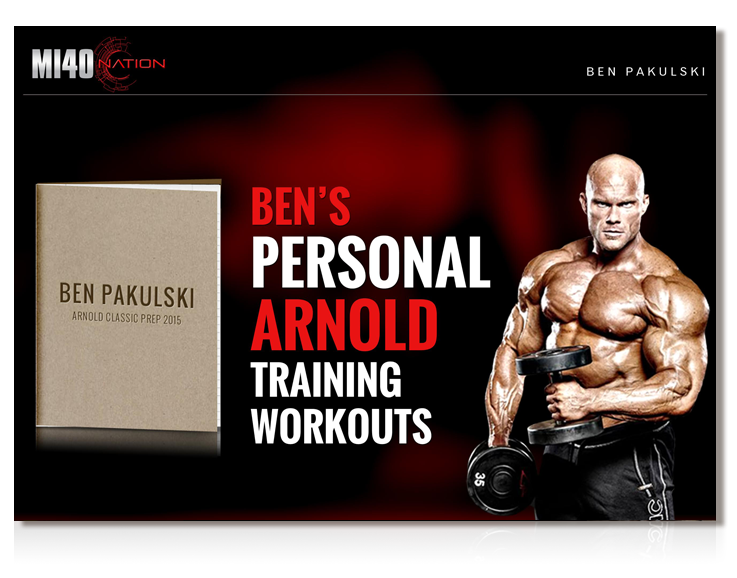
Ever wanted to know what it feels like to train like an elite pro on their way to the stage? Perhaps you’ve been looking for a top-level program to get you stage-ready yourself? Maybe you just want a ball-busting 6 week workout plan to see what you’re made of?
Well, whether your goal is to add some serious slabs of muscle, or shred lbs of fat (or both), these workouts guarantee results! The catch… there must be NO babying yourself! This is an elite workout plan for those brave enough to take on the challenge. You MUST follow this plan with honest effort and a hardcore mindset!
Are You a Bodybuilder Preparing for a Contest?
These workouts can be followed at any point during your prep, however, if you prefer to them leading up to the day of your show here’s how to do it:
1. Begin 36 days out – the final written workout of week 5 will fall 5 days before you step on stage.
2. 4 days out, objectively assess what your weakest body parts are, or decide on the 2-3 bodyparts you would most like to have stand out come showtime.
3. On 4 days out and 3 days out respectively, train the 2-3 chosen bodyparts with a sole focus on depleting them of any last remaining stored glycogen, nothing strenuous, high rep (≈15 reps), NO sets to failure. This approach will prep those muscles to benefit most from a carb-load leading into the show.
4. NO training in the final 2 days before stepping on stage – relax, focus on getting those carbs in as needed to make sure you come in looking full, hard, and diced!
5. Follow week 6 of the program in the week following your show while focusing on recovery strategies.
Boom!
-
Schedule
-
Sample
Please enter your name & email address below and we'll send you a sample workout from the program right away.
|
To keep gaining muscle, there are two primary things you MUST focus on… progressively maximizing TENSION… with MAXIMUM weight! …Time to get your game face on and strap in tight because this 6 week program is a true test of your manhood (or womanhood ;))!
Program Duration:
42 Days
-
About
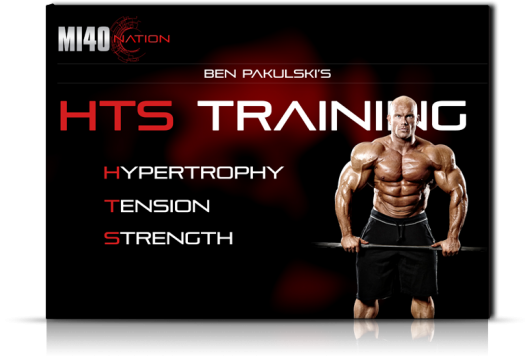
To fulfil your muscular potential, you MUST aim to progressively maximize TENSION… this requires consistently increasing the WEIGHT you can move over time, USING THE TARGET MUSCLE(s)!!
The next 6 weeks will see you improve your ability to generate more POWERFUL contractions, along with adding LBS to the bar seeing you get STRONG!! (…who doesn’t like moving some heavy ass weight ;))?
Always focus on generating tension in the working muscle first and foremost, but understand that doing chest presses with 5lb dumbbells won’t get you anywhere no matter how hard you’re contracting! You MUST get STRONGER over time to keep growing…
EXPLOSIVE contractions are one of the best ways to recruit more motor units and train your central nervous system to respond more efficiently. Motor units and muscle fiber types (I & II) are recruited in a specific order. The highest threshold units with the greatest potential for force output are recruited last, and will only be called upon once the force exertion required exceeds the capacity of the lower threshold units.
In other words, it should be clear that you will NOT get insanely strong or stimulate your CNS and fast twitch muscle fibers by using light weight!
Be aware that some of the techniques applied in this program are EXTREMELY challenging.
Get INTENSE, DRIVEN and FOCUSSED, but of course never sacrifice safety or form.
When doing this type of training, it is ESSENTIAL to properly prepare your tendons, ligaments, and muscles before stacking on the plates… unless you feel like taking a few weeks off training because you injure yourself.
Pay close attention to included techniques like progressive exertion sets and isometric contractions at the beginning of some of the workouts. These will prepare you to recruit more muscle fibers for the power/strength-based exercises and help you to avoid injury.
Now… don’t think that this is all just about lifting heavy.
The first two weeks are mostly focused on maximizing your mind-muscle connection (while adding some meat to those bones of course)… PAY CLOSE ATTENTION TO THE TEMPOS!!
The isometrics in both the shortened and stretched positions are to eliminate any momentum forcing you to control the rep with the target muscle.
There will also be extended time under tension sets and exercises focused on improving the mind muscle connection. These will take a great amount of focus and should push you just as hard mentally as they do physically…
DON’T take it easy on yourself! Squeeze that sh*t! Make it hurt, and FORCE it to grow!
This is an excellent time to focus on packing on some mass!
Higher calories and a bit higher carbs will help your CNS recover faster from the training to keep you growing as you get stronger.
Whether your goal is muscle gain or fat loss, nutrition is KEY!
If you need help in the nutrition department (or just want to avoid the hassle of planning it all), you can choose to get your hands on a personalized meal plan written by me, or instead my team can put together a great value done-for-you meal plan package – both options are available in the download area for the program.
…It’s time to get your game-face on and strap in tight, ladies and gents, this is going to be a true test of your manhood (or womanhood ;)).
Best of luck over the next 6 weeks, and remember… don’t baby yourself, if you want it, go get it champ!
Ben
-
Schedule
-
Sample
Please enter your name & email address below and we'll send you a sample workout from the program right away.
|
The rate-limiting factor for muscle growth is how quickly a muscle can recover from one training bout to the next. The more frequently you can train a muscle, the more often protein synthesis can be stimulated within it… the more often protein synthesis is spiked within a muscle, the faster it GROWS! Start your engines boys and girls, it’s time to ramp up your results with Scaled Frequency Training!
Program Duration:
42 Days
-
About

The traditional bodybuilding split calls for training each body part once per week. While that may be sufficient for a beginner, or in brief training blocks, it is NOT ideal if maximum hypertrophy in the shortest amount of time is your desired outcome.
On average, muscles are repaired within 48-72 hours depending on the size of the muscle and the extent of mechanical damage inflicted upon it.
The rate-limiting factor is how quickly a muscle can recover from one training bout to the next.
The more frequently you can train a muscle, the more often protein synthesis will be stimulated within it… the more often protein synthesis is spiked within a muscle, the faster it grows!
In highly-trained individuals, there is even evidence to suggest that protein synthesis can be localized as often as every 12 hours.
This means that with the right training and nutrition protocol, designed to optimize recovery, we can train the same muscle group more frequently, and grow FASTER.
Enter, Scaled Frequency Training!
Your nutrition will be of paramount importance over the next 6 weeks. To maximize your results, I highly recommend that you pick-up the meal plans I’ve designed for you – available through the download area for the workouts.
Now, when attempting to increase training frequency, total volume must be carefully considered.
Contrary to what we want, simply haphazardly doubling up on the same workouts during the week for example is likely to cause you to quickly overreach / attempt a volume that you are not yet prepared to recover from.
So the key here is intelligent planning, appropriate volume and careful exercise selection.
Over the next 6 weeks we will gradually scale up frequency and volume, building up to an ‘overreaching’ phase in week 5, and a ‘supercompensation phase’ in week 6.
You will notice that there will be less variation in exercise selection between some phases – I want you to become very effective / neurologically adapted to performing a few key movements (think, movement patterns), which will allow you to use maximal weight with optimal form.
If you have been following any of my other programs up until now, you will find that total workout volume for each body part will be lower than what you are accustomed to in each individual workout… that’s all part of the plan. You will be hitting that same body part more frequently each week.
However, you will still no doubt be tempted to add in extra sets / increase volume in the first two weeks in particular regardless… that would be a mistake! RESIST the urge!
Think of this as ‘the calm before the storm’.
The program will become more challenging as the weeks progress, but you will quickly begin to adapt, and, if your nutrition is on point, not only will you experience improved recovery, you will experience improved growth above and beyond what you may expect.
There will no 2 x training days in this program – you will need to maximize recovery between each workout, and the intensity will be undulated throughout the week for each body part.
Start your engines boys and girls, it’s time to ramp up your training frequency, and your results, with Scaled Frequency Training!
Ben
-
Schedule
-
Sample
Please enter your name & email address below and we'll send you a sample workout from the program right away.
|
By changing the execution, angle, or variation of an exercise, you can create a mechanical advantage allowing you to perform more reps with the same weight. Lactic acid and shortness of breath will be along for the ride as you engage upon a test of both your physical and mental prowess… stand tall, own it, and don’t let your mind quit before your body does!
Program Duration:
42 Days
-
About

This phase of training will be focused on boosting your metabolic rate with extended sets. These extended sets will be extremely demanding and cause A LOT of fatigue.
By changing the execution, angle, or variation of an exercise, we can create a mechanical advantage allowing us to perform more reps with the same weight.
These mechanically extended sets will make use of (mainly) tri-sets using intelligently selected exercises for our intended goal – these sets will be similar throughout the entire 6 weeks for each muscle group.
Your main goal / focus during these sets will be:
- To contract the muscle harder from workout to workout (especially important when working smaller muscle groups since #2 may not be possible each and every week).
- Minimal addition in weight (as in maybe 5lbs on a deadlift from week to week, 10-20lbs on the leg press, etc.)
Choose a starting weight that allows you to hit the target reps for each exercise of the first extended set WITHOUT a drop in weight – you should comfortably achieve the prescribed number of reps on the first exercise, and end close to failure on the final exercise of the extended set.
Here is a rough estimate for choosing the correct weight:
> Add together the target reps of the first two exercises, then choose a weight you could use to knock out that same number of reps if you were to perform just one set. E.g; if the first two exercises prescribe 10 reps each, choose a weight that would have you failing at about 20 reps if you did just one set of the first exercise.
The first set or two will feel light, and that’s fine, just squeeze the working muscle HARD throughout… by the end you will be fighting for every rep as the lactic acid accumulates.
Expect also to be out of breath when working larger muscle groups.
This will be a mental battle just as much as a physical one… but DON’T let your mind quit before your body does! Tough it out.
While this workout is effective for building muscle, it is also VERY effective for getting you ripped FAST… each workout will provide you with a metabolic effect helping to blast away bodyfat long after each workout is done.
You will be using less weight than you are used to during this program, but now is as important a time as ever to check your ego.
Those final reps will push you to your limits, and you will see a notable improvement in metabolic efficiency due to an increase in both stamina and muscular endurance. These adaptations will also carry-over to your future training leaving you able to crank out a greater number of high intensity reps.
Stand tall, own each and every rep… and go to your happy place when the burn kicks in 😉
Ben
-
Schedule
-
Sample
Please enter your name & email address below and we'll send you a sample workout from the program right away.
|
A key principle for generating long-term significant increases in muscle mass and strength is teaching your body to become strong and comfortable at the extremes of the muscular range. This is an underrated and underutilized ‘trick’ for sparking significant strength gains across the entirety of the range, while also hitting those neglected muscle-fibers to ignite new growth!
Program Duration:
42 Days
-
About

A key principle for generating long-term significant increases in muscle mass and strength is teaching your body to become strong and comfortable at the extremes of the muscular range. This is an underrated and underutilized ‘trick’ for sparking significant strength gains across the entirety of the range, while also hitting those neglected muscle-fibers to ignite new growth.
Teaching a muscle to become comfortable holding / stabilizing a weight at its end-points will improve your Active Range of Motion (AROM) over time while also decreasing injury risk both in the short and long-term. This last point is crucial as less forced time off means more time spent training and growing! Remember, he who breaks down least over time typically reigns supreme in the end.
Don’t be shortsighted and simply chase the weights at any cost… take the time to do this right, even if it will probably mean decreasing the poundage you can move at first – I don’t care if you can bench 400lbs if your range sucks. Neither should you!
Most people I come across are poor at generating force (and keeping tension) in the fully shortened and/or lengthened positions. One of the best ways to combat this is simply to spend more time there. During the next 6 weeks, give extra focus to initiating from the working muscle and ensuring constant tension throughout EACH and EVERY rep – NO exceptions!
Your focus in weeks 1 and 2 is to simply to try and keep the weights you lift (with perfect range) the same from workout to workout while the time spent under tension at the extremes goes up. After that we will begin adding additional volume.
It is VERY important during the program to keep detailed notes, in particular of the specific weights used and where exactly you failed. If you stay true to the aims of the program, by the time you reach week 6 you should find you are using noticeably more weight while performing every rep with the same full range / perfect execution. ZERO cheating. ZERO momentum. At ANY point.
Now, the first few weeks are your benchmark, so be focused and on it from day 1.
When you begin, you will probably want to pick a starting weight for each exercise you think would have you failing at 2-3 reps above the prescribed target. Moving into the extremes of the range is likely to be a little unfamiliar for you, and even more so keeping the weight there for an extended period of time.
The increasing intensity in weeks 3 and 4 will be taxing on your CNS, so after a short neurological de-load, we’ll crank the volume and intensity through the roof in week 5.
THIS is where you get to really test your mettle! THIS is where you really have to want it!
Assuming you survive week 5, compare your week 6 training to week 1, and measure your progress.
Now, before you jump into your first training session, here are a few ground rules to help you along the way:
1. NEVER go to failure on the first exercise. Aim to stop 1-2 reps short of failure on the first 1-2 sets of each exercise. The fatigue will accumulate quickly.
2. Test your active range of motion (AROM) before the first working set of EACH exercise, and be sure NOT to go past that to avoid other muscles beginning to take the load… that would defeat the point of the entire program. Remember, tension is king!
3. For the first set, aim to pick a weight that’s about 10-20% less than what you ‘think’ you should typically use. You will have ample opportunities to increase the weight later in the program, just be careful initially as you probably aren’t used to hitting the absolute extreme of the range. And don’t beat yourself up about that, it’s more than common – just drop the weight and focus on the objective.
4. As always, squeeze it like it owes you money, at ALL times!!
5. Finally, recap the objective before you begin each and every workout over the next 6 weeks. DO NOT allow yourself to get distracted. DO NOT allow your ego to get the better of you.
You got this champ… now get to work!
Ben
-
Schedule
-
Sample
Please enter your name & email address below and we'll send you a sample workout from the program right away.
|
When constantly pushing the envelope, it’s common to burn out the body’s ability to recover from volume, tissue damage, oxidative stress, and acidity etc. reducing the quality of our workouts. This further underlines the importance of intelligent periodization. During this program, training “stresses” will be rotated from workout to workout so that your training output can be maximized each and every time you set foot in the gym!
Program Duration:
42 Days
-
About

As you become more and more efficient when training, the stress you can tolerate at a muscular level, nervous system level, or with regard to a certain energy system in a single workout, goes up drastically. However so does your ability to stress these systems…
Over the course of many workouts, the body’s systems can become burned out at one or many different levels of recovery. A method commonly used by elite level trainees and athlete is Daily Undulating Periodization, or D.U.P.
The benefit of DUP is that it rotates the training “stress” from workout to workout. DUP is most commonly used in the strength and power world to keep lifters from overtraining their nervous system while also rotating the intensity of their training in a very different fashion than typical linear progression models. This same concept can be applied to hypertrophy and physique training.
Traditionally you would train your entire body under similar conditions, whether you are focusing on a strength, high volume, or metabolic phases for hypertrophy.
Much like a power athlete can burn out their nervous system easily, a person training for hypertrophy can burn out their body’s ability to recover from volume, tissue damage, oxidative stress, or acidity. A hypertrophy DUP cycle rotates the metabolic stresses that are typically overburdened with hypertrophy-style training. If you have ever had an insane leg workout during which you really felt the intense ‘burn’, then went to train another body part the following day only to fatigue very early, this is the exact thing that DUP is designed to prevent.
If our goal were to maximize total training output during every workout each week, your ability to recover from every training stress, would probably not be ideal.
Those who are the closest to pushing the envelope on recovery will notice the biggest difference from this style of training, even those who are not approaching their limits yet should still experience benefits from the variation it imparts on your training.
This hypertrophy DUP cycle will consist of 3 training types:
Neurological
Neurological-based workouts will be lower reps, more rest, heavier loads, and faster tempos. Power and strength-type movements require high voltage firing from the nervous system to contract a lot of tissue at once. The CNS is generally the most fatigued system from these types of workouts. Most people don’t know that a fatigued CNS typically takes at least a day longer to recover than the muscle tissue itself. This means you could “feel ready” to train before you CNS is ready for maximal output. By not overloading the CNS on consecutive days, we can allow it to recover while you train the other types.
Volume
These workouts will be the most familiar to bodybuilders and those training for hypertrophy. These workouts will stress the body via accumulating stress on the tissue. There will also tend to be a lot of stress on glucose transport and the faster energy systems. Overall, this type of training tends to be the most inflammatory.
Metabolic
These workouts are the most dense meaning the highest work:rest ratio, so lots of reps and not a lot of rest. This creates a high amount of stress on the body’s metabolism to keep providing energy, leading to a high degree of acid production and oxidation. So acidosis and oxidative stress are the main concerns here. These workouts create great improvements in metabolic efficiency, and are very effective for conditioning as well as building muscle.
However, chronic acidosis and oxidative stress can catch up to you if you can’t correct it fast enough, leading to performance and recovery drop-offs. When these systems are fatigued, all energy production in your body decreases leaving you feeling tired, flat, and your workout performance flat-lining. Giving you body a break from high lactic/oxidative workouts is a great way to allow your body to catch up on clearing acid and oxidants.
In summary: throughout this program you will be training every body part through each system, but never the same system two consecutive days. This means that your body as a whole has more time to recover from each type, while taking advantage of a fresher energy system in the next days workout.
Time to step up your game with Daily Undulating Periodization!
BPak
-
Schedule
-
Sample
Please enter your name & email address below and we'll send you a sample workout from the program right away.
|
High threshold muscle fibers require heavy weight for adequate stimulation, lower threshold fibers are best taxed with extended sets & finishers. This plan intelligently combines both to exhaust a high range of muscle fibers & create a very large lactic / growth hormone response. The next 6 weeks will be highly metabolically stressful - make sure you are prepared mentally and that your batteries are fully charged to go all guns blazing!
Program Duration:
42 Days
-
About
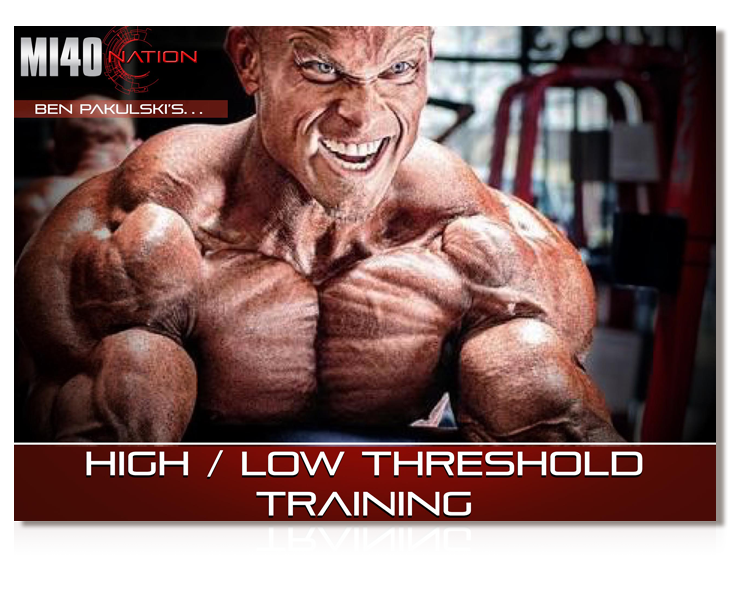
This plan uses a High/ Low Threshold system.
Each workout begins with a relatively heavy exercise to work the high threshold fibers and prime the nervous system. This allows the type II fast-twitch fibers to receive adequate stimulation before we move on to the lower threshold fibers.
Lower threshold fibers are slower, faster recovering fibers that must be taxed with extended sets and finishers. Simply using high reps to work the low threshold fibers would not adequately simulate the high threshold and medium threshold fibers given that the resistance is too light.
In this program, we’ll use a 8/8/15 rep scheme to ensure that we exhaust the higher and lower threshold fibers.
By exhausting the muscle in the 3 segments of a tri-set, we can exhaust a greater range of muscle fibers and create a very large lactic/growth hormone response.
This type of training is very metabolically stressful so we will fluctuate the volumes up and down over the course of the program.
Be sure to alkalize after training during these workouts with electrolytes and plenty of greens during the rest of the day to aid in recovery from the high acidic tri-sets.
This will not be easy, time to put the work in brah!
Ben
-
Schedule
-
Sample
Please enter your name & email address below and we'll send you a sample workout from the program right away.
|
If planned & executed intelligently, progressive wave loading gets a muscle stronger, FASTER! Increased neural output (from improved muscular strength) --> the more tension --> the more neural feedback --> the more cellular signalling for growth! Get stronger faster to get bigger quicker with Ben’s Progressive Wave Loading Protocol!
Program Duration:
42 Days
-
About
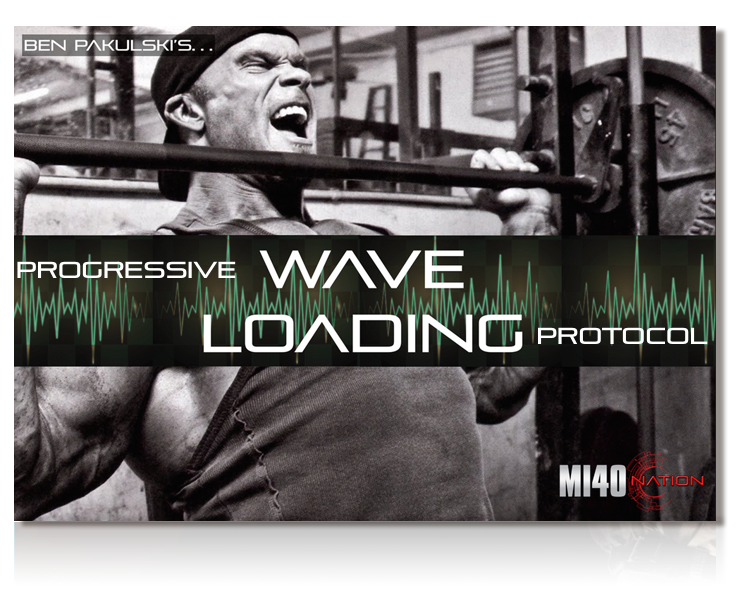
If you’ve been following my workouts for a while, you will be used to training your body to create tension, and to keep tension on the working muscle – now we want to turn our attention to increasing the amount of tension we can produce by focussing a little more on INTENSITY!
In the sense that I want to use the word here, the ‘intensity’ of a contraction can be viewed as the percentage of tension you can create in that muscle during the contraction, compared to your potential…
The greater the tension you can create, the more improvement in strength, and the more signaling for hypertrophy.
Tension and the nervous system are synergistic tools in creating growth in the muscle. The more powerful the neural output —> the more tension —> the more neural feedback —> the more cellular signaling for growth!
So how do you improve your neurological efficiency so you can produce more intense contractions?
> You have to utilize a rep scheme that primes the nervous system, and increases your contraction potential throughout the workout.
> You have to train the nervous with heavy loads that generate lots of tension within the muscle.
> You have to ensure that the intended working muscles are performing the movement, and that you are maximally contracting those muscles (like you will have learned in any of my primer phases).
> Last but no least… you have to progressively increase the load & tension needed!
Why Maximal Contractions are Important
In order to train the nervous system to recruit more fibers at once, you have to contract the working muscle with maximal effort each time. This ensures that you fire every neuron you are currently capable of, creating the highest intensity reps possible.
If you put any less than 100% into a rep, your nervous system backs off with regard to how many neurons it fires.
This is important for fine motor skills and finesse movements, but will get you nowhere in terms of increasing neurological efficiency to produce intensity. You must train with intense contractions to improve that intensity.
By consistently firing the maximum number of neurons you can, the nervous system adapts by learning to fire more neurons at once.
The training effect of maximal contractions is different to performing many reps to work all the muscle fibers. When you use sub-maximal contractions, some of the neurons and muscle fibers are resting while the others are working, and they rotate around each rep, even through parts of the rep.
However… there’s not a complete or constant contraction of all of the neurons and muscle fibers at once!
You can fatigue a muscle with constant reps, but it won’t be optimal for improving neurological efficiency.
Why Maximum Contractions with Heavy Resistance leads to the Most Growth
We are trying to increase your ability to create tension in the working muscle.
Maximum effort with little resistance or heavy resistance spread out from the target muscle will not work. The actual tension in the muscle is the most important factor for stimulating the big growth mechanisms like testosterone and local growth factors. Now in terms of hypertrophy, keep in mind that heavy is a relative term.
For this phase you MUST learn to create as much tension in the muscle by using intent, proper technique, and the proper amount of resistance!
Structure of the Training
Progressive loading refers to a periodization plan where the number of reps decreases each week… and because the reps decrease, the weights used should increase each week.
When focusing on increasing the intensity of contractions, we are training the nervous system to adapt to contracting more fibers at once. This produces the greatest improvements in the lower rep ranges.
Additionally, as you adapt to a load in one week, in order to get the nervous system to adapt further, you must increase the resistance, which increases the neural demand.
A progressive loading scheme allows us to plan increasing loads on the nervous system.
Since the volume and intensity of training is much higher, the frequency between bouts of training for each individual body part will be low.
You will be training each body part only once per week… so MAKE IT COUNT!
Just because your muscles may recover from the workout in a few days, this does not mean that your CNS (Central Nervous System) has recovered. The heavier loads used during this program place a MUCH greater demand on your CNS and it will take longer to recover… this is why you will have a rest day after your two most neurologically demanding workouts (back and quads).
Wave Loading
All but one workout a week will begin with a wave loading protocol…
The first ‘wave’ of the exercise (the first 3 sets of descending reps) will prime your nervous system for the subsequent wave.
Using day 2, exercise 1 as an example:
Sets 1, 2 and 3 (8 reps, 6 reps and 4 reps respectively) should be regarded as the first ‘wave’.
Set 4 (8 reps) would then be regarded as the beginning of the second wave.
* The first wave should NOT be to failure, but be within 1-2 reps of failure using hard, controlled, explosive contractions!
When you begin round 2 with the higher rep set again (set 4), you should now find that you can produce a greater, more powerful, higher intensity contraction than you did in the first round of the wave!
** The second wave should be heavier than the first, and you should hit failure on the last 3 sets…
…your spleen should be about ready to burst! 😉
This approach is a GREAT way to facilitate increases in strength… FAST.
Following on from these demanding wave loading sets (especially demanding from week 3 onwards) we’ll add in some more typical hypertrophy work to facilitate some growth to accompany what should be some drastic strength increases!
BPak
-
Schedule
-
Sample
Please enter your name & email address below and we'll send you a sample workout from the program right away.
|
Training a muscle to lactic failure is a great way to signal many hypertrophy pathways - be tough & embrace the burn! Expect to see noticeable changes in body composition during this program as you will be stressing your total lactic tolerance... one of the key ways to increase growth hormone secretion similar to that seen from HIIT! Keep your head down, work hard, & get ready to grow an extra pair over the next 6 weeks!
Program Duration:
42 Days
-
About
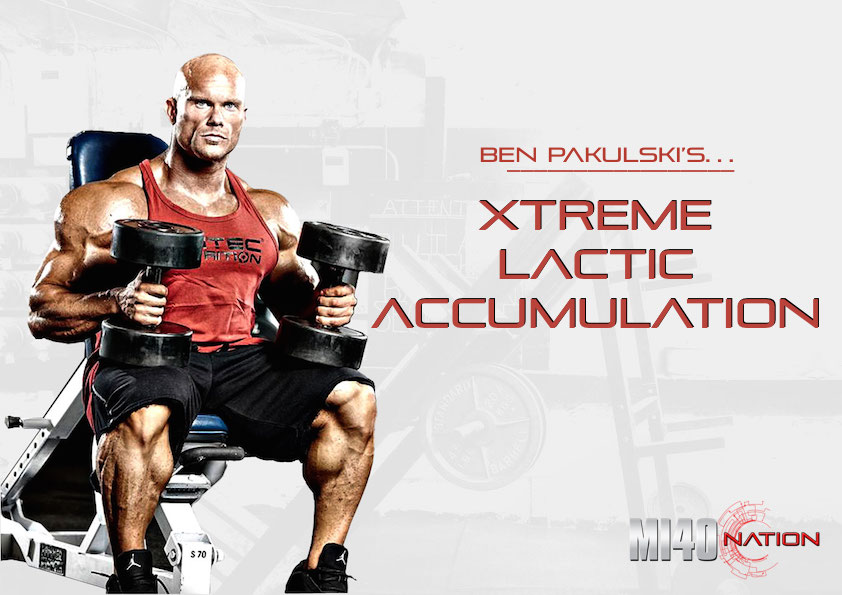
If you want to get the most out of your lactic training, your systemic conditioning cannot be a limiting factor.
The problem with most people lifting for muscle growth is they may stress an individual muscle in terms of lactic threshold, but they very rarely do this to their entire body. So the limiting factors become not the muscle your trying to work, but your ability to clear the waste being produced by that muscle so it can keep working. Take for instance a very hard leg workout…
Many people if they take a set of leg presses to failure have to allow for an absurd amount of recovery time before they can repeat that effort. This isn’t because of their quads, they are systemically out of shape in terms of dealing with all the metabolites the legs are generating.
This is likely not a problem when you’re working a very small muscle, but for large muscle groups, this can greatly cut down on your training volume and intensity if you don’t improve your total lactic tolerance.
Training a muscle to lactic failure in a set is a great way to signal many hypertrophy pathways… however your ability to repeat those high effort sets is dependent upon your ability to clear the lactic and other metabolic metabolites from the muscle and replenish the energy producing pathways.
Some of this happens within the muscle, but a large part of recovery is dependent on your muscles shuttling out lactate and other metabolic waste into the blood where it is then metabolized by liver and even other surrounding musculature.
This sudden rush of metabolites in the blood is why your heart rate and breathing increase after a hard set to failure.
You need the extra oxygen to fuel these aerobic pathways to clear the metabolites from the anaerobic work – the rate at which you can do this will ultimately determine how much volume of lactic work you can do, and how dense you can do it.
For the first half of this program, you will be stressing the total lactic tolerance by training multiple muscle groups in superset, and multi-set fashion. This will allow you to create a greater overall load on your entire body’s ability to deal with lactic acid and the other metabolic waste products. Your aerobic capacity will improve, and your cardiovascular system will become more efficient.
The net effect of the total lactic period will condition your body to recover faster from lactic work.
In the second half of this program we are going to take advantage of your improved conditioning and start testing each individual muscles ability to push its lactic threshold. This will be done by way of supersets and NOS variations in a dense training fashion.
When you reach this point, your systemic recovery should be improved, and you should be able to stress each individual muscle with more prolonged sets and less rest… ultimately increasing the amount of work and stress that the muscle is going to get each session.
To summarize, we will improve our entire body’s conditioning and lactic tolerance in the first half of the program, then when we switch to training for maximum lactic stress for each individual body part, we will have no limitation beyond the working muscle.
Expect to see noticeable changes in body composition as you move further into the program, you’ll be stressing your total lactic tolerance… this is one of the key ways to increase growth hormone secretion similar to that seen from HIIT!
Time to toughen up and embrace the burn…
So, stay focused, fully committed, and get ready to grow an extra pair over the next 6 weeks 😉
-
Schedule
-
Sample
Please enter your name & email address below and we'll send you a sample workout from the program right away.
|
Every top bodybuilder on the planet has the ability to contract a muscle to an INSANE degree... no exception. You will NEVER significantly build the size of a muscle with weak sh**ty contractions... it just won’t happen. Over the next 6 weeks you will learn to increase the quality and intensity of your contractions for explosive pro level gains!
Program Duration:
42 Days
-
About
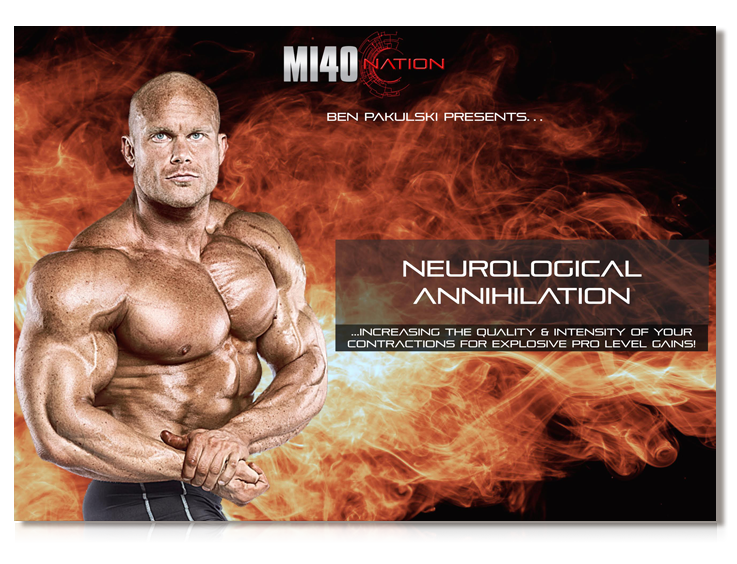
As an MI40 Nation member I will assume you are busting your balls week in week out and following my advice to the letter… I’ll also therefore assume you are seeing progress that is ahead of the curve.
While I genuinely believe I am giving you THE best training information and workouts you’ll find anywhere, if my training advice REALLY is the best, why are there still IFBB Pros training in a manner that would appear suboptimal, almost seeming to fly in the face of what I’ve taught you?
Valid question right?
Well, there’s maximising workouts by training optimally, and then there’s training sub-optimally but seeing results in spite of this…
While there are various factors that play a leading role in how well a person may respond to exercise, some of those are outside of our control.
Take ‘genetics’ for example… if someone “chose better parents” than I did, then I have to train harder, eat better, and approach things in a smarter way than they do to be in with a chance of coming out on top. Simple as that.
I therefore have no choice but to put my focus on optimising what I CAN control, and avoid wasted time sitting around lamenting what I can’t.
Some people will still see fantastic results in spite of a seemingly inferior approach – I accept that, it’s just a reality among the elite. The top 0.1% can bypass many important factors.
BUT…
There are some common traits that ALL top pro bodybuilders share in common, ones that you must work on if you are serious about making significant progress.
Over the next 6 weeks we will turn our attention to one of the most important…
Intensity of contraction
Every top bodybuilder on the planet has the ability to contract a muscle to an INSANE degree… no exception. You will NEVER significantly build the size of a muscle with weak shitty contractions… it just won’t happen.
While it’s true that many pro’s have God awful form which you’d think would inhibit their progress, pay close attention to their ability to contract the working muscle… no doubt it will be on a whole other level to 99% of the world.
Now obviously I don’t encourage sloppy form, I’m merely pointing out the importance of being able to develop a heightened ability to contract a muscle. Optimizing your execution should still be a priority if you want to maximise your time and results.
As an example of a high profile top pro that deserves massive respect, but doesn’t exactly train optimally from a biomechanics perspective, I’ll mention my good buddy Branch Warren.
While he may not train the way I would personally recommend, his ability to contract is INSANE.
In my humble view, he would probably see even greater results if he followed the sort of exercise execution I teach, but no one can argue that the dude’s not a freak and among the best around (though there’s no doubting who has the more impressive wheels ;)).
The moral of the story… you MUST work on improving the skill of contraction – it is a NECESSITY if you want to add more than just a few measly pounds!
Progressively stronger muscular contractions not only improve your ability to stimulate tissue growth, they also make your muscles more receptive to utilizing the foods you eat, thus increasing the “margin for error” in your nutrition.
The next 6 weeks will be mainly about increasing the quality and the intensity of your contractions, as well as encouraging neural adaptations – if followed precisely, soon you could be on your way to joining the ranks of the elite and growing like a pro!
Sound good?
Well let’s move on to the meat of the program…
Workout Structure
As I have implied already, increasing your ability to recruit more muscle fibers during every contraction – neurological efficiency – is essential to maximizing your ability to rapidly build muscle. You can hit your optimal levels of volume and frequency, but if you are only engaging a fraction of your potential muscle tissue during each rep, your progress will also be a fraction of what it could be.
When training for neurological efficiency, it is helpful to minimize the number of ways one may ‘cheat’. We will take advantage of exercises that will allow us to better “lock it down” and avoid extraneous movement. As a result, the number of exercise variations will be less than in many of my other programs – this is intentional – it will not only help in reducing time spent setting up and changing stations, but it will force you to better focus on increasing the quality of your contractions in a single movement pattern.
There are practice sets written into these workouts, but they should not replace any warm-ups you may typically do such as isometric activation sets.
The goal of the first sets of each exercise is to practice squeezing the muscle all the way into the fully shortened position. A1 and A2 exercises are specifically selected to provide the least amount of resistance in the lengthened positions, while increasing during the concentric – therefore DO NOT launch or initiate forcefully out from the bottom of the rep… initiate slowly with maximum control, gradually squeezing harder and harder as the muscle becomes shorter and the resistance increases.
B1 and B2 exercises will be the same as those performed during A1 and A2 sets. This is because your body has been primed for hard contractions with those particular movement patterns. This is where we will focus on increasing the intensity of those contractions and maintaining continuous motion.
C’s and D’s will follow the same pattern as A’s and B’s, but will emphasize overloading the lengthened and mid-range of motion. Aim for a HARD initiation, and then focus on increasing your mental ability to contract as the relative resistance decreases.
Finally, because I know you love lactic acid 😉 …some intensifiers await you at the final hurdle – the goal is to produce some metabolites and increase bloodflow, nutrient update, insulin sensitivity, as well as stimulate a greater hypertrophic response.
_
As always, frequently assess your active range each session, apply ‘intent’ whenever possible, and remember… this is about increasing QUALITY and INTENSITY of CONTRACTIONS… NOT about moving more weight.
Squeeze it ‘til it cramps soldier.
BPak out
-
Schedule
-
Sample
Please enter your name & email address below and we'll send you a sample workout from the program right away.
|
When it’s time to optimize your body composition transformation, some tactics are better than others. Here, intensity, frequency, volume & density are manipulated strategically so that you can fan the flames of your metabolic furnace, while at the same time continuing to mold a muscular physique. Get ready to carve out deep striations in rapid time with Advanced Build & Shred (ABS)!
Program Duration:
42 Days
-
About
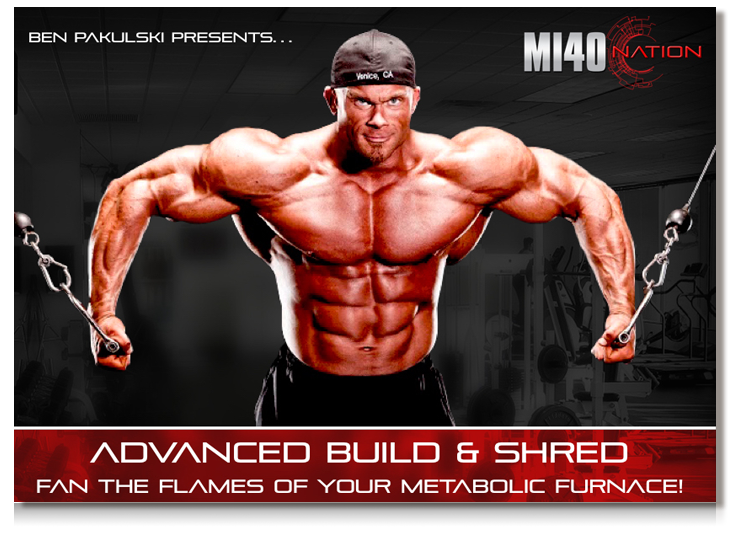
When your goal is to improve body composition (more muscle, less fat), there are four primary factors that must be carefully manipulated within your training.
Each plays an important role in preserving, or even building, muscle while optimizing your ability to burn off excess body fat: Intensity, Frequency, Volume, Density.
Here is how each contributes to your ultimate goal…
Intensity
More specifically, the intensity of your contractions. This is not to be confused with EFFORT, or working “hard” in the gym. The more intense the contractions (using greater loads with excellent execution), the greater GLUT-4 translocation will occur within muscle cells. GLUT-4 has the ability to shuttle glucose into the muscle and store or burn it WITHOUT the need for insulin.
This means that your insulin levels will stay lower, improving your sensitivity to it, while increasing your potential to partition nutrients and replenish glycogen.
Frequency
The more often you train a muscle, the more frequently you can sensitize it to glucose and improve your insulin sensitivity. I cannot emphasize strongly enough how essential insulin sensitivity is for both muscle gain and fat loss. The more you train, the more more opportunities you have to stimulate growth (assuming you are adequately recovered).
Volume
As it relates to body composition, the greater the volume (more specifically, the higher the “quality” of volume / work – optimal execution and hard contractions), the greater the overall energy expenditure you will produce. Fat loss requires an energy deficit to occur – when the goal is to maintain, or even potentially to gain muscle at the same time, we ideally want to keep calories as high as possible while increasing output (volume) to create this deficit. The key is to gradually scale up total volume, rather than jumping to the maximum amount you can handle – this is where the principle of the, “minimal effective dose”, (or MED) comes in… just doing enough each week to stimulate additional fat loss and prevent a plateau.
Density
Doing more work in less time is one of the simplest ways to skyrocket your metabolic rate and increase EPOC (Excess Post-Exercise Oxygen Consumption). Basically this just means you will continue to burn additional calories for hours after your training is over. Increasing density is great for burning off fatty acids, however, the denser the training, the less resistance you will be able to use over the course of your workout, and the lower the intensity you will be able to train at. We will use this knowledge intelligently to find the balance we’re looking for.
Putting It All Together
For the most, “bang for your buck”, each of these factors must be strategically incorporated for optimal body composition improvement. I’ve written Advanced Build & Shred (ABS) to achieve just that.
Frequency is relatively high throughout. There are sessions targeting both intensity and density, alternated appropriately to allow for adequate recovery without impeding performance. Total volume is gradually scaled up from week to week to progressively push you mentally and physically. A de-load period has been strategically placed in part way through to allow you to go on and CRUSH the last 2 weeks of this program where things will be toughest.
2x/Day Training
If you have the ability to train 2x/day a few times during this program, it is HIGHLY recommended you take advantage of the optional AM workouts in weeks 3-6. They are mainly intended to excite the central nervous system to get it and you fired up to smash the PM metabolic work. The goal of the A.M workouts is stimulation, do NOT exhaust yourself – avoid going to failure on all but the last set of each exercise. Focus more on improving the intensity of your contractions.
If you decide to pick up the meal plans for this program (recommended), you will simply remove the ‘Anytime’ meal and have an additional Post-Workout shake after the AM session if you train after breakfast.
If you train first thing in the morning (before breakfast), remove the breakfast meal and have the PWO shake after the AM session. Keep the ‘Anytime’ meal and place it appropriately during the day so you are still eating every 3-4 hours.
_
Boom… time to get shredded while sculpting that physique!
Ben
-
Schedule
-
Sample
Please enter your name & email address below and we'll send you a sample workout from the program right away.
|
Functional hypertrophy, strength, & metabolic style training, strategically compressed into 6 weeks of growth inducing, mentally toughening, increasingly intense workouts. There’s no smoke without fire... here’s your growth spark! Boom! Intelligently rotate & intensify your training to ignite explosive gains with Strategic Cyclical Overload!
Program Duration:
42 Days
-
About
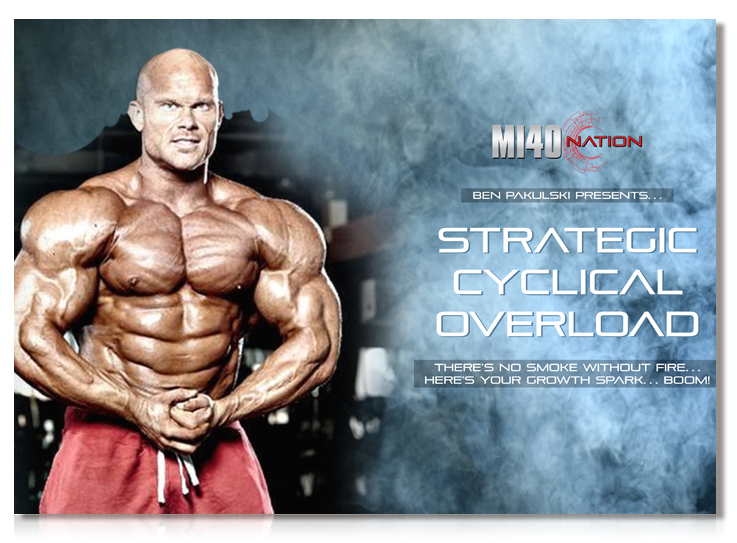
I’ll tell you this upfront… the split and periodization of training stimulus in this program will force you to break through a number of mental and physical barriers.
It will be uncomfortable, ball breaking at times for sure, but accept that now and leave it behind – just another obstacle to overcome on your path to a better body and a better you!
The workouts are strategically rotated so we can continue to push our limits throughout – some days are designed to heavily test our total lactic tolerance, while others will push our Central Nervous System (CNS).
The goal is to utilize as many hypertrophy pathways as possible while allowing the alternate energy systems to recover.
We will cycle between different stimuli (strength, functional hypertrophy, and volume / metabolic work) as well as adjusting the training frequency of each as we move through the program.
Ergo, while recovering from mechanical damage and our CNS is recuperating, we will crank up the volume and density to maximize our lactic acid production (to stimulate hypertrophy from accumulation of metabolic stress).
You will note that the strength days are less frequent than the volume / metabolic style days – this is a result of heavy strength training causing much more mechanical damage, and the CNS needing longer to recover.
The body adapts more quickly to metabolic stress, so workouts at lower intensities(*) can be used more frequently.
(* “intensity”, in bodybuilding terms means the actual resistance relative to your 1 rep max, it does NOT mean how much effort you put in – a common misappropriation of the word).
You may be familiar with the concepts of sarcoplasmic and myofibrillar hypertrophy – basically the size of the individual muscle cells versus the density of muscle fibers (if you have the relevant MI40 Nation membership, here’s an article walking you through it) – this program is designed to increase both.
As I sometimes like to do (not just for the purposes of torturing you ;)) there are some double training days in the last two weeks of the program. If for a valid reason you can only do one session, choose based on your primary goal – if you need to focus on strength training and improving intensity of contractions, go with the A.M session; if you are primarily focused on fat loss or achieving maximal hypertrophy, go with the PM session.
To make the most of the program, detailed meal plans are available.
Ladies and gents, boys and girls, there’s no smoke without fire. Prepare to scale new heights and ignite new gains… this is your growth spark… BOOM!
BPak out
-
Schedule
-
Sample
Please enter your name & email address below and we'll send you a sample workout from the program right away.
|
Through the intelligent use of cluster sets, we can increase the intensity of total volume for HARDCORE advances in size, strength & work capacity. Designed to separate the men from the boys, it’s time to test your mettle & give your metabolism a kick up the rear with Functional Metabolic Loading!
Program Duration:
42 Days
-
About
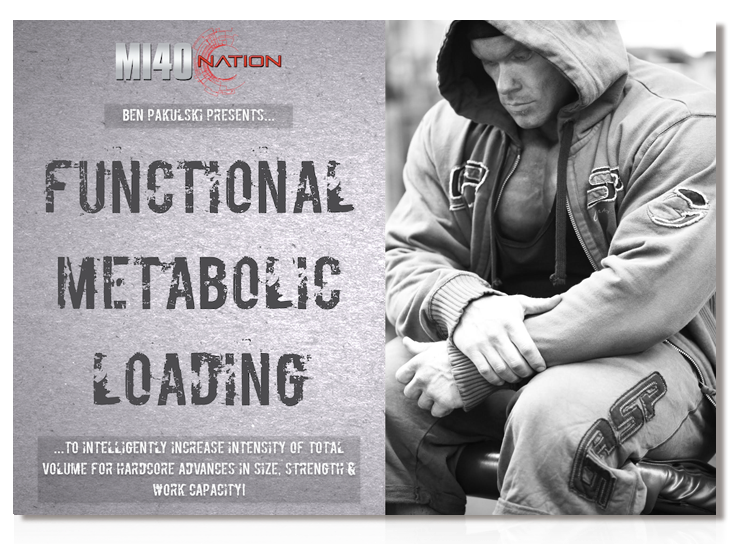
Functional hypertrophy commonly refers to a rep range of around 6-8. The intensity is high enough to elicit strength improvements, while also allowing you to perform enough volume and time-under-tension to stimulate hypertrophy.
The goal of the Functional Metabolic Loading program is right in the name… we will take advantage of the higher intensity from training in the functional hypertrophy range, then we will incorporate some intensification techniques to increase the volume of training using heavier loads.
This is VERY demanding, both physically and mentally, so get fired-up before you hit the gym and pay close attention to your diet over the next 6 weeks to aid in your recovery.
Our primary intensification technique will be ‘Cluster Sets’. Something I learned from one of my mentors and one that I have used with great success personally and with clients… but be warned:
While extremely effective, Cluster Sets are NOT for the feint of heart!
In other words, leave your purse at home when you hit the gym during this program!
If performed correctly, you will be increasing reps by 50% beyond what you would typically be able to achieve with a particular weight during a straight set to failure.
Ergo, same weight, more reps. Higher volume, at a higher intensity. That’s muscle math equalling gainz!
While more than appropriate if you’re looking to add muscle, the program will also facilitate a boost in metabolism if your primary goal is to shed mounds of fat.
In addition to Cluster Sets, CS-6 sets and NOS-X sets will also make appearances… 2 more gruelling but effective techniques paving the way for rewarding results.
(We all need a butt kicking every now and then, so don’t be surprised if the acronym, “F.M.L”, takes on it’s more familiar meaning over the next 6 weeks 😉 ).
How to perform Cluster Sets
The format you will see written when Cluster Sets are prescribed is ‘4/4/4’ (for example), each number representing a mini-set.
Take 15 seconds rest between each mini-set.
To choose an appropriate weight to use, add the first 2 numbers / clusters together, then pick a weight that would have you hitting failure at that number of reps if you were performing a straight set with no rest.
For example, if the cluster set prescribed is 4/4/4, choose a weight that would normally have you failing at 8 reps.
Perform 4 reps, rest 15 seconds, perform another 4 reps, rest 15 seconds, perform your final mini set of 4 reps.
In essence, you’ll be performing 12 reps with your 8 rep max.
The first cluster should be relatively easy… so there should be NO excuse for anything less than 100% perfect execution.
The second cluster should see you narrowly avoiding failure on the last rep, again with perfect execution. Lactic acid should be accumulating now.
The last 2-3 reps of the third cluster should have you struggling as you push towards your limits. Drive with purpose, embrace being uncomfortable, and expect a MASSIVE pump as blood courses through your veins and into the muscle worked. If you are looking for hardcore results… this is the time to summon your inner beast.
While explosiveness and max effort are part of the game, DON’T take your eye off the ball and allow your execution to drop off – we are still chasing reps that count towards our goals, not reps for the sake of reps.
Though the target reps will also be relatively low compared to what you might be used to, the extended intensity will not only facilitate an increase in mechanical damage, but also in metabolic stress from the short rest and maximum output… growth factors conducive to packing on pounds of rock solid mass.
_
In closing, this program will separate the men from the boys and build some character… as well as some serious muscle.
Respect the level of effort required, in particular during the Cluster Sets.
Do not sell yourself short… Go HARDCORE, or go home!
Time to test your mettle. You ready?
Ben.
-
Schedule
-
Sample
Please enter your name & email address below and we'll send you a sample workout from the program right away.
|
It’s been scientifically demonstrated that by stimulating a muscle from multiple angles, greater hypertrophy can be achieved. Here we take this knowledge & combine it with a multi-set approach to maximally fatigue all fibers of our target muscle-groups. Embrace the burn, pull-up your big boy pants, & get to work. It’s time for Muscle-Fiber OVERLOAD!
Program Duration:
42 Days
-
About
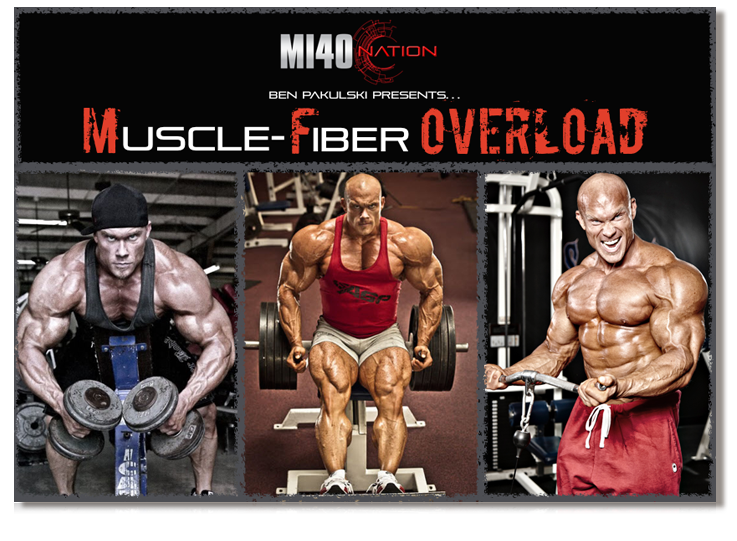
One of the classic principles in bodybuilding is that you must train a muscle in different positions, or with resistance at variable points in flexion.
This has been shown scientifically to enhance hypertrophy.
By training the muscle with the maximal resistance at varying points of flexion, you can stimulate a greater number of fibers.
Each exercise you perform is biased to the muscle fibers that offer the greatest contractile strength at the range of the movement.
The following workouts work by training each muscle group through 3 dfferent points of flexion so that you can maximally fatigue 3 separate groups of muscle fibers within the same muscle.
If we take biceps for example:
A2: Standing Curls places the bicep at a middle range in relation to the shoulder and the resistance is greatest in the middle of the range of motion.
B2: Incline Curls places the biceps in a stretched position, and now the greatest resistance is closer to the bottom of the range of motion.
C2: Prone Incline Curls places the biceps in a short range in relationship to the shoulder and the greatest resistance is now towards the top of the range of motion.
By simply changing the angle of the upper arm in relationship to the torso and gravity, you can get a new stimulus, even though for all exercises the range of motion is simply flexion at the elbow.
____
Learn to embrace the burn…
It’s time to pull up your big boy pants!
Ben.
-
Schedule
-
Sample
Please enter your name & email address below and we'll send you a sample workout from the program right away.
|
Using a combination of strength work & volumization techniques, the aim of each workout is to exhaust, maximally stimulate, & flood your muscle cells with lactic acid. The result is a pump so big you’ll look 20lbs heavier at the end of every session! Whether you’re trying to cut down your waistline or build up some impressive size, this program will deliver in spades!
Program Duration:
42 Days
-
About
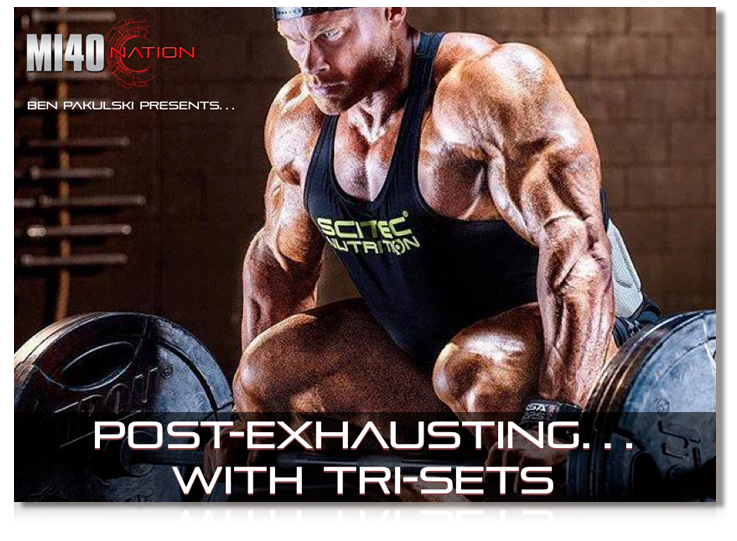
This program utlizes some strength-work, strategically combined with tri-sets comprised of carefully selected exercises.
First we will hit the high threshold fibers with heavier loads in the strongest position.
Then we follow-up by using tri-sets in an effort to fatigue the entire muscle from multiple angles by stimulating as many of the lower-threshold fibers as we can.
This approach should provide a boost in lactic acid and give you a SICK pump that can be showcased as you strut through the club after your workout is done ;).
Caused by maximal blood and cell volumization, the “pump”, known scientifically as ‘cell swelling’, or ‘hyperemia’, has been shown to trigger an “adapt or die” type response by the muscle cells!
The excessive swelling acts like a trigger to get bigger…
…and / or face potential cell death from excessive intracellular pressure!
Sounds intense…
It is!
This particular program has an upper-body dominant focus, utilizing 2 seperate torso targeted days.
One will be centred around vertical pushing and pulling, the other working in a horizontal plane.
____
Stay true to form to reap the benefits of strength increases on top of all the cell swelling goodness you can handle…
It’s time to use the metaphorical bicycle pump to balloon our way to bigger (and stronger) muscles!
Ben.
-
Schedule
-
Sample
Please enter your name & email address below and we'll send you a sample workout from the program right away.
|
As a by-product of forced up-regulation, tremendous jumps in muscle-growth can be achieved post-MI40-Xtreme. This protocol was designed to squeeze every inch out of this window of opportunity by shifting gears & letting the magic happen via strategic facilitation, not annihilation. This is not a super sexy program full of fireworks, it’s a low volume program with a specific purpose: to help you receive some much needed recovery, while simultaneously rewarding your hard work over the last 6 weeks by coaxing it to manifest into maximum results over the next 6. Less work, more growth = intelligent progress. Profit from your recent efforts & make sizeable gains with the Post-MI40-Xtreme Protocol!
Program Duration:
42 Days
-
About
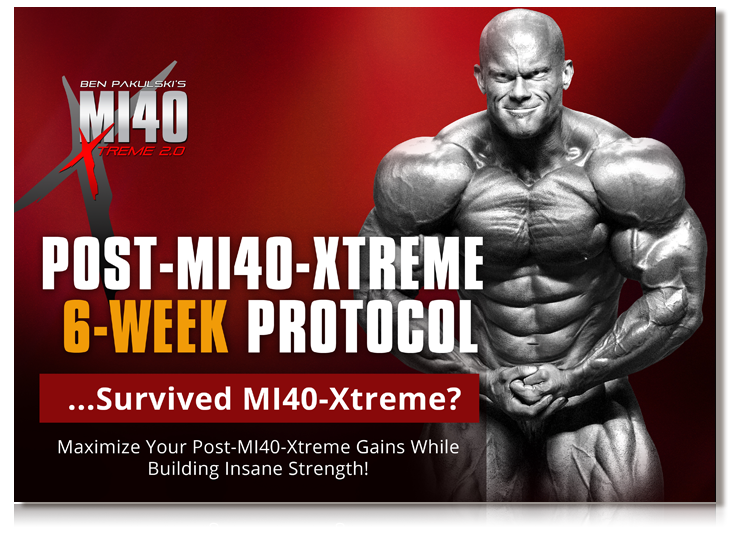
So, you’ve worked your butt off for 6 weeks with MI40-Xtreme…
You’ve just about crawled past the finish line…
You’re beaten…
You’re bruised…
You’re desperate for a break…
BUT… what if I told you this is actually the most important time to stay vigilant?
Really? Why?
Because NOW is the absolute BEST time to profit from your efforts & make tremendous gains!
Let me explain…
If you followed MI40-Xtreme as prescribed while putting in the required effort, you have primed your body for SUPER-COMPENSATION – a window of opportunity during which you can experience higher than usual growth spurts.
This is due to the ‘Planned Overreaching’ built into the MI40-Xtreme program which results in a hyper-growth rebound-effect if you play your cards right.
If we were to continue on with the level of effort and volume required during MI40-X, we are likely to cross a threshold into a zone counter-productive to muscle-growth and recovery, resulting in stagnated muscle-growth and continued decreases in performance, or worse, possibly even overtraining.
(The graph below provides a brief depiction of overreaching (and supercompensation) vs. overtraining:
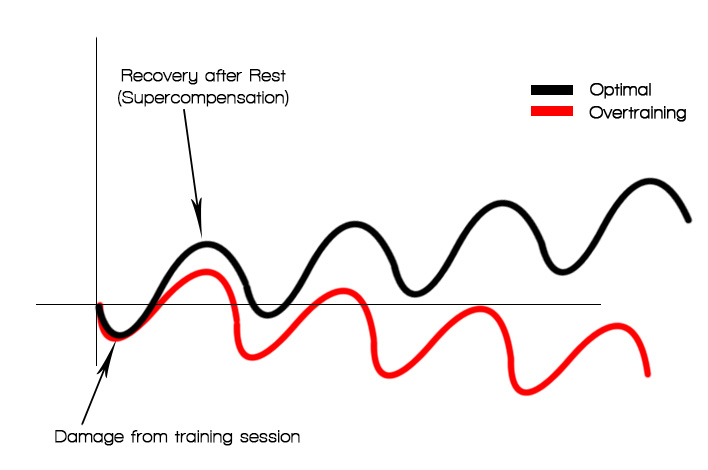
The black line represents the aim of normal training — damage the body, then let it recover to a level above where we started. The red line represents the effect of overtraining, where we keep pushing our body without giving it enough time to recover, which inevitably leads to regression.)
Overtraining is what happens when we train for too long and too hard; despite our best attempts to recover via sleep, nutrition, and supplementation, the body just cannot recover – like taking one step forward and two steps back.
(* All Access Xtreme and VIP-Inner Circle members – you can read more about planned overreaching vs. overtraining here.)
Simply put, MI40-X should have pushed your body to its limits, so now it’s time to back off before we cross that line…
…but we should do so intelligently.
In the environment left by MI40-Xtreme, we don’t need a program with lots of fireworks – we need a simple but smart program that works. A program that largely lets the magic happen via facilitation, not via annihilation.
Supercompensation
Immediately after completing MI40-Xtreme, take at least 3 days off (from training) before you begin this program.
During this time, follow the Phase 7 diet calculators that came with MI40-Xtreme.
If you have the required All Access Xtreme or VIP Inner-Circle membership, give this a read for an optimal nutritional approach during this time – it will help you to make sure you get the most out of this rare growth opportunity.
Don’t waste it!
The Program
At this point your body should be accustomed to high volume and high frequency workouts. All things being well, MI40-Xtreme will have forced an up-regulation of your recovery ability to keep-up with the demands the program placed upon it.
For a time, your body will remain in this state – meaning that it will continue to produce adaptations beneficial for hypertrophy and recovery at an elevated rate.
We want to take advantage of this.
Enter, the Post-MI40-Xtreme Protocol!
The key now is to switch gears strategically.
We want to offset the decrease in performance you are likely to achieve if you were to keep ploughing on, while at the same time maximizing your opportunity for some SERIOUS growth over the next 6 weeks…
This is a relatively low volume program causing minimal muscle damage (primarily to aid in your recovery) and focuses on cell swelling and different angles.
By decreasing our-workload, but training strategically, we can simultaneously get the recovery we need while maximizing hypertrophy.
…LESS WORK but MORE GROWTH!
This program is simple in its approach, as it should be in the context of what we’re trying to achieve. Despite it not being the sexiest program you ever choose to do, it is a SMART program to follow with an expressed purpose… to make the most of your window of opportunity!
The first few weeks are a great opportunity to focus on contractions and re-perfecting your form… make use of this time!
Progression is built into the program so that as your body become accustomed to lower volume, there is a crossover period whereby the workouts become more challenging to keep you moving forward.
_
If you have just completed MI40-Xtreme and are looking to squeeze every inch out of the window of opportunity created for massive jumps in muscle-growth, the Post-MI40-Xtreme 6-Week Protocol will get the job done.
Less work, more growth = intelligent gains.
Maximize the hardcore grit you put into the past 6 weeks by following it up with the Post-MI40-Xtreme 6-Week Protocol…
Ben
-
Schedule
-
Sample
Please enter your name & email address below and we'll send you a sample workout from the program right away.
|
German Volume Training has been a popular go-to approach for many bodybuilders, powerlifters & olympic lifters, ever since Charles Poliquin brought it to the mainstream in the mid-90s. While traditional approaches have proven to be effective, following this MI40-style advanced variation will see you progressing at a more impressive rate. Advanced GVT is your hardcore blueprint for rapid-fire gains in size & strength...You provide the perseverance... Advanced GVT will provide the results!
Program Duration:
42 Days
-
About
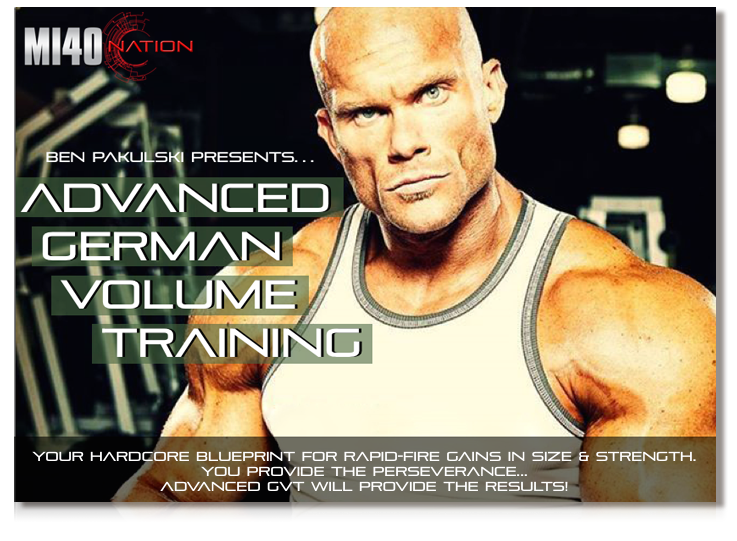
The logic behind the program will be explained here soon!
If you’d like to get started on the program right away, it’s available for download now!
-
Schedule
-
Sample
Please enter your name & email address below and we'll send you a sample workout from the program right away.
|
Want to command instant respect? Well boulder-shoulders are a must! Shoulder-width is also highly linked to sexual attractiveness... so get those delts a’poppin’ to see the bedroom a’rockin’ with my delts specialization program!
Program Duration:
42 Days
-
About
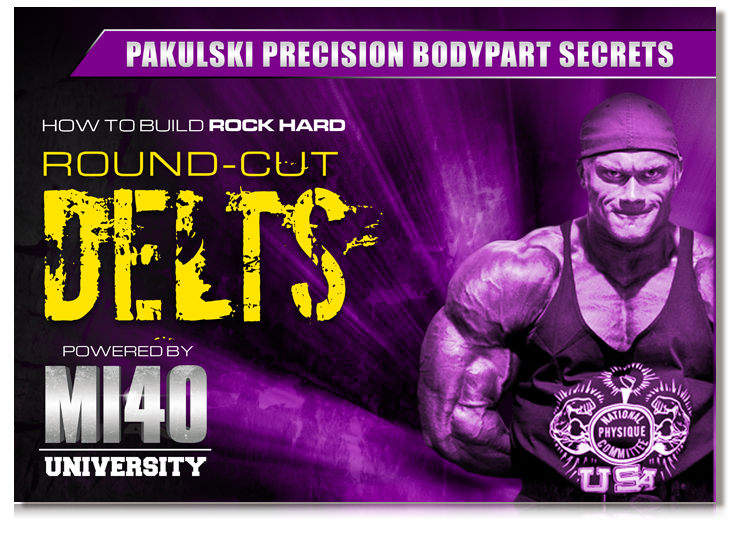
Due, in large part to the structure of the human skeletal system, there is perhaps no other muscle group that will elicit more of a dramatic aesthetic change through hypertrophy relating to the entire physique, than delts.
Unfortunately, the popularity of delt training amongst gym rats has led to an influx of misconception and misinformation. There are a plethora of observable downfalls in general delt training, and simple alterations to your routine can allow you to experience an exceptional amount of hypertrophy in a small amount of time.
So long, of course, as you are willing to analyze and implement the key features of anatomy, exercise execution, and injury prevention.
Anatomy
The deltoids, which are composed of three ‘main’ muscle bellies (actually 12 in total), originate at the later third of the spine of the scapula, the acromion, and the lateral portion of the clavicle. These origins run halfway down the lateral humerus.
The actions of these muscle bellies present a considerable amount of overlap due to their shared attachment on the upper arm. In many cases, it would be best to consider the deltoids to be singular muscle groups, as opposed to three separate muscle bellies.
The deltoids act in unison with several smaller muscles (e.g. rotator cuff) to serve rotation of the glenohumeral joint (GH joint) in varying positions of the arm.
Also, the deltoids act to stabilize compression forces back into the joint. Delt training often presents a high injury risk, and thus careful precautions should be taken to not overly stress the joint, which can have a detrimental effect on the muscle tissues.
Such precautions will ultimately lead to an increase in hypertrophy and are outlined as follows:
1. Understanding Function
Grouping shoulder training can be a difficult task. It’s extremely common to see the delts grouped primarily alone, most likely under the notion of specific focus leading to optimal hypertrophy. This concept works great with other body parts, but specialization of the delts alone can have more effective alternatives.
Front delts, being an exceptional example, function in unison with the pecs for horizontal abduction. All incline chest movements place outstanding resistance on the front delt. Thusly, the volume of chest training will likely be directly correlated to the amount of taxation of the front delt. It would therefore be optimal to group ‘front delt training’ with chest, and not as a collective whole of the deltoids.
Likewise can be said about placing posterior (and to an extent, medial) delts with back day. In essence, it is logical to create a push/pull body part split when grouping the deltoids into training with other body parts. This, in turn, will ensure maximum recovery.
2. Resistance Variation Considerations
Chiefly, we see the majority of delt training being performed through free weight utilization, to an almost exclusive extent at times. This conventional way of training can add a redundant element to your workout, despite the fact that you may change exercises often.
Let’s consider the dumbbell press and the barbell press:
These are two staple movement patterns that are used in nearly every training routine. Despite being different movements, they offer nearly identical resistance profiles. In order to train optimally, it is vital to change the resistance profile (where the resistance is stressed relative to the portion of the movement).
An easy way to ensure you’re changing resistance profile is to frequently include an excess of training tools such as bands, cables, machines, and the like. Cable Side Laterals, for example, offer a different resistance stimulus than the traditional dumbbell lateral raise, which exerts force only downward due to gravity.
3. Consider Risks
As touched upon briefly, with shoulder training comes unavoidable risk factors of potential joint wear and injury with particular movements.
Below are a few exercises that can, over time, be detrimental to your training as a result of prolonged wear on the joints:
Upright Rows:
These function in similar fashion to lateral raises (shoulder abduction) and are generally coupled with an excessive passive internal rotation of the arm. The movement, which also engages the biceps and trapezius, introduces additional scapular movement which restricts GH joint motion. Also, the movement can cause irritation of the biceps tendon and cause wrist discomfort due to excessive ulnar deviation. If you choose to do these, keep them light and space hands shoulder-width apart (as opposed to close together which is typically seen).
Behind the Head Presses:
When performed behind the head, military presses can induce risk to the anterior joint capsule and often calls for an alteration of head position during the movement to ensure, what many consider, to be a full range of motion.
Instead, utilizing a high incline bench and pressing to the front will not be any less effective in regards to muscular stimulation, and will certainly decrease the risks.
‘Heavy’ Dumbbell Lateral Raises:
Using heavy dumbbells to execute lateral raises oftentimes calls for excessive bodily motion and uses limited resistance during the lower portion of the movement (to the point of essentially zero resistance at all).
This external rotation of the humerus against resistance will increase joint stress and also removes the stress load from the medial delt. In short, this will likely lead to limited hypertrophy and, perhaps worse, being limitations in joint function over time.
Dips:
Again, too much passive shoulder extension can irritate the joint capsule, thus placing excessive, undue stress on the anterior delt. In order to increase safety on the shoulders’ behalf, it is important to practice manipulations in form, bringing the body into a more horizontal position. Be aware though, that emphasis is then placed largely on the triceps.
4. Fully Shortened Range of Motions
Many reverse flys motions (used to target rear delts) are often incomplete.
The location of the rear delt causes an increase in emphasis drastically during humeral extension, nearing the shortened end of the movement. In order to optimally target the rear delt, exercises like rows and reverse flys need to be accompanied with a constant fully shortened range in mind.
Conclusion:
Decreasing injury risk, and increasing the likelihood of hypertrophy through appropriate deviation of resistance, can both be accomplished through the same changes. Be sure to carefully analyze exercise selection as to increase the variance of the resistance profile, as well as to place a great deal of consideration on the anatomical functionality of the shoulder as a whole.
-
Schedule
-
Sample
Please enter your name & email address below and we'll send you a sample workout from the program right away.
|
Want to build a back so huge you can see it from the front? Want towering traps like a titan? Take charge of your v-taper right now with my HERCULEAN back building blueprint!
Program Duration:
42 Days
-
About
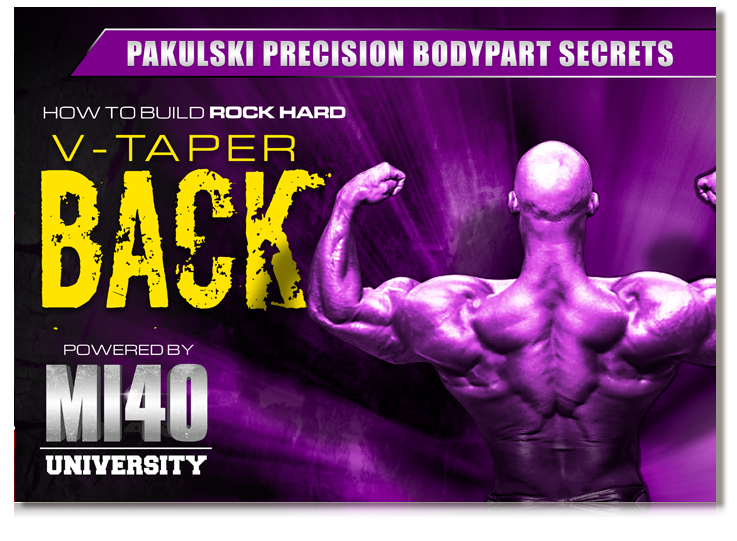
There are numerous factors that make the back the most difficult area of the body to develop in terms of muscular hypertrophy and strength.
Lack of good back development amongst physique athletes in most cases is never a manifestation of lack of training and effort, but rather incorrect techniques and limitations of an understanding of anatomical functionality.
With innumerable ‘fitness experts’ and personal trainers posessing limited education, it’s no wonder the basics of back training are often misinterpreted or marred amongst the proclamation of ‘revolutionary techniques.’
Advanced movements are by no means unacceptable in terms of implementation into your routine. There is, however, much to be said concerning the importance of focusing on the basic principles, in order to target specified areas of the back, with the optimal resistance desired.
Anatomy
The back is composed of a large variety of muscle bellies. In bodybuilding, the ‘lats’ (latissimus dorsi) receive the greatest amount of attention due to their excessive size when compared to the remaining musculature.
The lats span both sides of the back, from the superior and medial part of the ilium (pelvis), the lower spine via the spinous process of the lumbar spine and lower thoracic spine, all the way up to attach to the lesser tubercle of the humerus – after passing and attaching to the inferior angle of the posterior scapula.
Unlike the pecs, the lats present differences in fiber directions and movement resulting from several joints. These, of course, can ultimately determine the specificity of movement patterns to determine which area of the back receives stress during resistance training.
Lats function for several joints, as mentioned.
Such include:
• Retraction, depression, and downward rotation of the scapula
• GH (glenohumeral) joint extension, internal rotation, and adduction
• Lumbar and thoracic extension
• Side-bend and rotation
The other main constituents of the back relative to a bodybuilder include the Teres Major, which attaches from the lower, lateral, posterior scapula, to the humerus – as well as the Trapezius, which attaches from the thoracic / cervical spine / skill to the scapular spine.
The Trapezius, commonly referred to as the ‘traps’, are itemized into upper, middle, and lower divisions. Lastly, the Rhomboid (both minor and major) attach from the upper thoracic vertebrae to the scapula (medial).
These given attachments will allow us to have knowledge concerning how to structure our back routine. They will assist in exercise selection and execution.
Exercise Selection
Developing a back routine can be an exhausting task for some given the nearly infinite number of possible combinations of movements.
Experience levels, goals, and personal mechanics should all play a pivotal role in your selections. Keep in mind that there are no ‘secret’ exercises that will ultimately lead you to an increase in hypertrophy, more so than simply following the basics with concentration on form and function.
Often times, the problem of ‘basics’ lies in the fact that they can NEVER be emphasized enough. Often the blame can lie with the failure of the many trainers to iterate their importance.
Below is a list of common mistakes, as well as accompanying corrections, that will yield an increase in results if followed:
Ignoring Motion of the Scapula
Lat involvement in a given exercise is primarily influenced by scapular movement.
Due to the body’s inevitable struggle to make movement patterns ‘easier’, proper scapular movement is essentially impossible unless a mindful effort is made to do so.
In exercises such as traditional cable rows, barbell rows, and machine rows, the scapular motion should call for retraction during the concentric portion of the movement. This method recruits both the traps and the rhomboids to emphasize the contraction of the lats (amongst other, secondary muscles).
Whenever an athlete changes the plane of motion (e.g. lat pulldowns), it is important that scapular motion parallels the respective movement pattern. Scapular motion should remain directly in opposition during a given exercise.
In the pulldown example, ideal movement of the scapula is downward rotation and depression.
This process is often arduous for those lacking experience.
A common way to help alleviate this is to focus on scapular motion and humeral motion as two separate entities. Each rep is seemingly two separate movement patterns formed into one. Through progression, exercise execution will ultimately become more fluid and will become a single motion.
Handle Selection
Handle selection during cable exercises is specific to the individual, however there are general rules that apply. For most athletes, the traditional close-grip attachment is sufficient for both row and pulldown variations.
A common issue arises when individuals enter the concentric portion of the movement, as the arms inadvertently leave the sagittal plane.
Handle width should be correlated proportionally to an individual’s shoulder width (e.g. those athletes with wider shoulders should utilize wider handles).
Using a handle that is too narrow will lead to resistance of GH joint internal rotation as well as decreasing the available range of motion. Ideally, an optimal situation would call for an athlete to use a parallel grip handle that is at least shoulder width.
Trunk Instability
A lack in sufficient trunk stability, especially during back training, will lead to an inability to experience maximum resistance whilst still maintaining desired form. What’s more, such deficiencies (or at least the lack of consciousness concerning stabilization of the trunk) can lead to injury.
The anatomic location and function of the lats presents a dilemma: traditional exercises (all rows, pullovers, pulldowns, etc.) are unable to simply apply forward resistance solely at the glenohumeral joint. In addition, resistance is experienced by the entirety of the spine. A limiting factor will often times be observable through inadequate hip strength or underdevelopment of the spinal erectors / abdominals.
Generally, motion at the hips should be limited (if not eliminated completely) during rowing exercises to maximize effectiveness as well as safety. Using an excessive amount of resistance does nothing in terms of benefit to the lats, or the accompanying muscles.
Those who lack trunk stability (and are preferably working to alleviate this deficiency) can benefit from lying prone during rowing exercises (such as on an incline bench or T-bar row machine with a pad). Furthermore, limitations in spinal rotation should be observed and worked to correct during one-arm rows and similar movements. Despite the common belief concerning the perceived benefits of ‘stretching’ the lats, spinal motions can lead to injury and again do essentially nothing to benefit the back.
Lack of Machine-use during Back Training
Back, perhaps more than any other muscle group, presents the highest inclination to benefit from the use of machines. This, of course, is due in large part to injury prevention and maintenance of ideal resistance / form as discussed above.
Machines offer the ability to create and manipulate different resistance profiles, which is essential to optimizing hypertrophy over time. An exercise’s ‘resistance profile’ is an analysis of where the movement is difficult, and where it is easy (i.e. where the highest resistance is experienced).
During free weight movements, gravity causes the resistance profile to be exclusively downward. Machines allow the athlete to experience variations in resistance profiles by offering changes in resistance at the extremes of the movements.
Pullups and Pulldowns – Hand Positioning
Common ‘gym knowledge’ presents the notion that using wider grips has an effect on the width of one’s lats. This fallacy can lead to extreme reductions in back stimulation. Fixed bars will ultimately determine stimulation as well as movement.
Pulldowns offer several options with regard to handles and grip-width, which therefore leads to options in planes of motion. Most commonly, we utilize the frontal plane (experienced when doing traditional, wide-grip pulldowns / pullups).
Specificity and precision in grip-width is very important to optimizing stimulation. Lack of adequate width, or too much width, can lead to limitations in range of motion. If the hands are too wide, range of motion is limited during the shortened and lengthened end of the movements. If the hands are too narrow, range of motion can be displaced by the elbows, thusly leading to limitations at the shoulder.
Optimal hand positioning requires that hands be positioned at slightly less than the width of the elbows while the shoulders are at 90 degrees.
Some individuals have structural frameworks that are inclined to ‘foldability’ (generally those with narrow shoulders and long arms), and can thereby be at a mechanical disadvantage. These athletes will typically experience the most benefit from using a shoulder width-grip, which will transfer motion to the sagittal plane.
Many individuals present an active range of motion (AROM) that is less than 180 degrees, or directly above the head. This causes an undesirable amount of stimulation of the lats. It’s imperative that one monitors active shoulder flexion prior to selecting a pulldown angle. Backward lean (without swinging) is advisable for those who are unable to access 18º degrees of flexion.
Conclusion
There isn’t a document or article in the world that can definitively summarize all the important aspects and recommendations for back training. This though can serve as a great tool to guide you into making informed decisions about the structure of your routine, as well as the nuances associated with optimal exercise execution.
-
Schedule
-
Sample
Please enter your name & email address below and we'll send you a sample workout from the program right away.
|
Constantly accused of skipping leg day? Have legs like your 12 year old sister’s? It’s time to change all that... for good! Add some SERIOUS MEAT to those chicken drumsticks with these HARDCORE TREE-TRUNK BUILDING workouts!
Program Duration:
42 Days
-
About
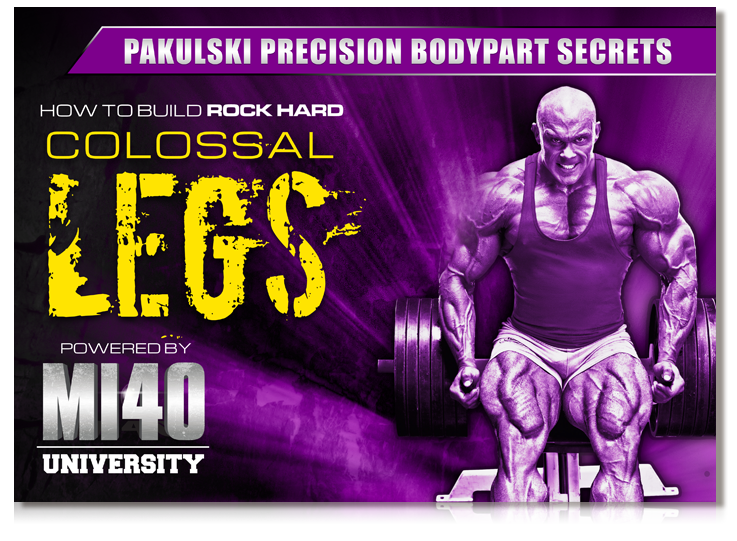
Quads: The Logic
An unavoidable ignorance lies in the rampant misinformation concerning quad training. Reserved exclusively for the truly dedicated and the ‘hardcore’ of sorts, training quadriceps requires two primary premises that most fail to meet: intensity and specificity in movement patterns.
The following are 10 techniques that are a definite catalyst to substantial quad growth. Say ‘goodbye’ to lacking gains and years of looming frustration.
1. Squats are NOT always ‘king’
The squat has successfully solidified its place among the annals of great exercises.
Generally we find that individuals with phenomenal leg development heavily favor the movement, even so far as to state that one, “can’t get big legs without squatting.” Despite a plethora of benefits, the squat, biomechanically speaking, is not necessarily a must in all athletes’ training routines.
Majorly, some people are not predisposed to significantly benefitting from traditional squatting, and this begins with structure. We can look at individuals with long femurs for example. If one’s femur to shin and/or femur to torso ratio is large, the individual will inevitably encounter some mechanical difficulties when squatting, compared to an athlete with short femurs and a longer torso. The former, bending at the hips for balance maintenance, will unknowingly place stress on the spinal extensors. This weight displacement, in turn, takes the load and tension off of the quadriceps.
We can also observe issues with ankle joint mobility. Athletes with dorsiflexion deficits will over-pronate at the feet. This break in proper mechanics then transfers proximally to higher joints (e.g. knees, hips).
The above example helps to show that there are very rarely any constants with regard to exercise execution in terms of mechanical advantages to the individual. The squat’s chief selling point is that it works an extensively wide range of muscles. This statement, though correct, yields the need for deeper insight.
To what degree of stress and tension are these various muscle groups exposed to? Again, this is not a constant variable and requires an analysis of each individual.
Some of the aforementioned disadvantages can be overcome, to a certain degree, with minor changes in execution.
Some examples include changing heel position (increased dorsiflexion or plantarflexion), hip rotation coupled with stance width, and load placement. If these manipulations have little effect, it is completely plausible, and perhaps very likely, that squats are mechanically NOT the best exercise for you.
2. Training ‘light’ is more favorable than training too ‘heavy’
Understanding the relativity of how ‘heavy’ a particular load is (or any amount of tension) is imperative for maximizing hypertrophy. A common theme that stops people from optimizing the amount of muscular growth they experience in the lower body, comes from using a weight or resistance that is outside the realm of their functional capabilities. Form and range of motion are often compromised when an athlete focuses on adding more weight (generally this limits said athlete to under 6 reps).
Most hypertrophy of the quadriceps occurs within a higher rep range (often up to 15+). Focusing on time under tension and shortened rest periods between sets are key elements to more growth. Longer stimulus application (i.e. higher rep ranges) will elicit an adaptation to fatigue, which, in turn, will respond with advanced muscle growth over time.
3. Isolation exercises can be your best friend
It’s as cliché as any phrase in bodybuilding – “Compound movements are for mass building.” Be that as it may, that statement is used to imply that isolation movements are less effective when attempting to maximize muscular hypertrophy. A primary example discrediting this fallacy can be observed through leg extensions.
In order to make this (and other isolating movements) effective, there needs to be an emphasis placed on hip positioning, tempo, joint recruitment, and range of motion. If these points are followed correctly, leg extensions will be your best friend.
Speed of the motion also needs to remain consistent throughout the sets. Utilizing the same speed at the extremes of the motion (peak stretch and peak contraction), as one would throughout the rest of the movement, is vital. This will ensure maximum tension and stimulation.
4. You cannot change the ‘shape’ of your quadriceps
This same principle can be applied to all body parts, and this is a product of genetic shape. Regardless of the effort placed on emphasizing a particular muscle belly, the shape of the quadriceps will remain fixated in the wake of hypertrophy.
This concept can be explained by reviewing the anatomic structure of the knee as it pertains to quadriceps contraction.
Your knee functions much like a hinge, thus the quadriceps muscles have no way of changing knee motion aside from a single plane. Regardless of knee positioning, it is impossible to create a differentiation in muscular contraction during knee flexion.
5. ‘Full’ range of motion is NOT necessarily optimal
‘Full’ range of motion is perhaps the most misused term in exercise physiology. It is often thrown around with limited understanding behind what true full range of motion is, and whether or not it is optimal to follow. When we examine leg training, a ‘full’ range of motion typically implies going as far as the body will allow the weight to go (specifically on pressing movements such as leg press). If an external load influences more motion than the quadriceps can control, passive motion is experienced. This passive motion will disallow for time under tension concepts to be applied. Muscle growth aside, this can also impair joint function and mobility.
The ‘full’ range of motion of pressing movements (again, e.g. leg presses and squats) is feasible for some goals, primarily powerlifting or strength sports. In bodybuilding, however, this has minimal purpose as the emphasis needs to be placed on hypertrophy.
6. Lunges are overrated
Lunges have become a staple in nearly every bodybuilder’s leg day arsenal, and with good reason. Lunges, in fact, are an effective movement for providing a stimulus to the lower body, especially the quadriceps if particular intentions and foot placements are observed.
There are, however, a plethora of needed prerequisites in order to make lunges optimal for muscle growth. Ankle mobility, balance, and hip strength (both adduction and abduction) are all key variables that are stressed to a high degree when performing lunges. If any of these are weak points for an athlete, the tension can be easily shifted, which again will eliminate time under tension optimization. A common fix for these (aside from implementing movements that strengthen these necessities) is to simply take smaller steps (optimal quadriceps emphasis) and stopping ‘briefly’ after each rep. if necessary.
7. Utilize intensifying techniques
Again, this is a principal that can be applied to all body parts, but holds specific significance concerning the quadriceps. Using drop sets (decreasing the weight during consecutive, nonstop sets) and supersets (combining two or more exercises in consecutive fashion without rest) will elicit a great deal of hypertrophy. These provide the greatest amount of tension in the shortest amount of time. The increase in fatigue response is crucial for muscle growth in the quads.
8. Increase your frequency
Placing a priority on quad training is an effective tool in maximizing growth potential. Although there is something to be said concerning the neurological stress of an intense leg day, it is certainly combatable with proper nutrition and sleep, and thus should have zero limitations on one’s ability to increase frequency. Studies have shown that the amount of recovery time needed for a muscle does not exceed four days (this is being generous and rounding up for most literature). That said, the body has no concept of a seven-day week. Increasing the frequency of one’s quadriceps training will yield greater results than doing a traditional ‘once per week’ protocol. Keep in mind, soreness can be a sign of inflammation and quite possibly a lack in adequate nutrition.
9. Hip adductors are key to adding more size
Hip movements (adduction for the sake of hypertrophy) are a severely under-utilized set of exercises for many bodybuilders. Although there is minimal functional application, the importance of adductor strengthening movements cannot be underestimated relative to hypertrophy of the quads. Nearly 1/3 of upper leg mass (muscular tissue) can be stimulated through hip adduction, and rarely obtains this stimulation elsewhere.
10. Disregard ‘aerobic’ forms of cardio
A common mistake for many bodybuilders is utilizing extended durations of aerobic cardio for fat loss.
While these methods my work, they can be extremely detrimental to quadriceps muscle retention. Extended periods of aerobic training will de-condition the anaerobic potential of the quads.
Eventually, the quadriceps will attempt to adapt to this newfound aerobic stimulus, thus muscle loss will inevitably occur.
Of all the muscle-groups, hamstrings and glutes are perhaps THE most misunderstood with regard to hypertrophy training. I’ve perused copious amounts of literature, most of which is inherently vague and lacks TRUE, functional application.
We are all well aware of the exercises needed for maximum stimulus of the glutes and hams. There are however, a great number of very specific nuances that are key for optimal gains. Slight changes in form and execution will skyrocket your progress, so long as you make specific, anatomically sound corrections.
Anatomy
The hamstrings compose of four, tendon-like muscle bellies, located on the posterior of the femur.
In essence, there are three primary components, all of which cross the hip joint and originate at the inferior aspect of the ishial tuberosity:
• the long-head of the biceps femoris
• the semimembranosus
• and the semitendinosus
The fourth muscle belly, the short-head of the biceps femoris, is located on the distal end of the femur.
Each of the four acts in knee flexion due to their respective insertions. The aforementioned three primary muscle bellies act, not only in hip extension, but also in external rotation and adduction while in the neutral position.
The glutes, anatomically referred to as the gluteas maximus, originates from the gluteal line, inferior aspect of the lateral crest of the ilium, the posterior / lateral aspect of the sacrum and coccyx, and inserts into the gluteal tuberosity of the posterior femur.
The other gluteal components, the medius and minimus, are significantly smaller and less superficial. There is no specific need to discuss their functionality here for those interested in hypertrophy.
The gluteas maximus, however, functions as an external rotator, adductor, and extender of the hip joint. Moreover, it is one of the strongest muscles found in the human body.
As mentioned, there are several small changes that can be purposefully implemented to change stimulation patterns, most notably with the hamstrings. Changes in hip and knee positions are the primary examples.
Being able to conceptualize the mechanical advantages and disadvantages of small changes is the key to optimizing hypertrophy.
Active Range of Motion (AROM)
As with all muscle groups, it is extremely important to take careful assessment of one’s available range of motion. It is specifically important with these muscle groups, due to the susceptibility to injury of the knee joints or chronic wear.
Both knee flexion and hip extension need to be controlled and should never exceed the depth your hips are able to concentrically flex.
The term ‘full’ range of motion is often misused and generally should be focused on ‘active’ range of motion. Failure to adhere to a joint’s passive range (by exceeding it) is a near certain way to ensure a hindrance of progress going forward.
Compound Movements and Hip Extension
Glute work, and to a much greater degree, hamstring work, is often identified through isolation movements. There are in reality though a surplus of ways to increase or decrease the force load and tension on these muscle groups during compound movements typically thought of as quadriceps exercises such as leg presses, squats, and lunges.
These are where the minor manipulations come into play, to a crucial extent.
Leg Press
The prime alteration will come in the form of foot placement (high vs. low). The amount of tension placed on the hamstrings and glutes vs. the quads varies greatly with even a fraction of an inch worth of movement along the plane.
The higher the feet are placed, the more hamstring and glute activity will typically be experienced. Furthermore, the aspect of intentional force (e.g. ‘driving’ through the heels) while focusing on hip extension (thus reducing knee extension) will also increase hamstring activity.
Squats
Since there is the added element of free weights, traditional barbell squats prove to be more difficult to shift focus from one muscle-group to another. In order to appropriately plan your form, it is important to consider your structural makeup. Athletes with long femurs and short trunks and tibias should generally use a ‘wide’ (greater than shoulder width) stance.
Those who disregard this often fail to reach the lower portion of the active range of motion. In addition to a wider stance, outward rotation of the hips can greatly increase the amount of glute and hamstring stimulation.
Lunges
Lunges are a staple for many bodybuilders trying to get the most out of their posterior lower- body. Unfortunately, many fail to execute this movement in an optimal way, and hence end up placing too much emphasis on the quadriceps.
A primary concern with lunges focuses around the prerequisites of ankle mobility and abduction strength. If these two areas are lacking, the lunge will be largely ineffective with regards to targeting the glutes and hamstrings.
It is recommended to implement single leg-abduction movements into your regular workout protocol. A phenomenal way to further accentuate the focus to the glutes and hams is to halt movement at the top of each rep (during walking lunges) and simultaneously drive the hips back.
Hip Extension Movements
Stiff-Legged Deadlifts
‘Traditional’ deadlifts are a great way to target the posterior chain, but also create lots of tension on the quadriceps. This presents us with stiff-legged deadlifts to alleviate the issue of quad-dominance.
This deadlift alteration works to remove resistance away from the hips, thereby placing the desired emphasis on the glutes and hamstrings though increased contraction throughout the range of motion.
Note, however, that the term ‘stiff-legged’ is a potential misnomer. It is recommended to keep a slight knee bend (whilst maintaining this exact bend throughout execution) in order to alleviate undue stress on the knees and allow the hamstrings to have greater force production near the bottom of the rep.
Similarly to a traditional deadlift, keeping the bar (or dumbbells) near the shins will lower the amount of resistance at the trunk, creating a much more accommodating resistance profile. With free-weights, there will be a reduction in resistance at the top of the movement (to zero).
In order to change the firing patterns at the extreme, experiment with cable and attachment variations.
Glute-Ham Raises / Back Extensions for ham & glute emphasis
When performed correctly, can be effective at near isolation of the glutes and hamstrings while using ‘intent’. Sticking out the glutes, as opposed to swinging with the back, while attempting to kick the legs through the leg pad will account for emphasis on the glutes and hamstrings.
Knee Flexion Movements
Seated Leg Curls
The most effective way to isolate the hamstrings in this movement calls for bodily control. Brace the body using the arms and keep constant abdominal contraction (to a degree).
Furthermore, it is important to place emphasis on hip extension.
The more that the gastrocnemius can be lengthened through dorsiflexion, the more effectively the hamstrings can be targeted.
Lying Leg Curls
The number one concern with this movement is observable through anterior pelvic tilt. It is difficult to manipulate at times, but it can be effectively done. Again, abdominal contraction will help to keep the glutes from coming up, which keep tension on the hamstrings, so too driving the hips into the pad throughout.
Standing One-Leg Curls
The execution of this movement is similar (in terms of intent and hip control) as the lying leg curl. Keep certain to eliminate trunk rotation that results in lumbar spine extension.
The underlying theme of the above is that the focus on hamstring and glute development comes from exercise execution, not from exercise selection.
Although each movement presents pros and cons in terms of hypertrophy, small manipulations can effectively alter resistance loads and firing patterns.
-
Schedule
-
Sample
Please enter your name & email address below and we'll send you a sample workout from the program right away.
|
Suffering from a flat chest? Or maybe the dreaded man boobs? Take your pecs from PUNY TO POWERFUL and unleash your inner THOR! This program is the KEY to unlocking MONUMENTAL CHEST GROWTH earning you GREEK-GOD status!
Program Duration:
42 Days
-
About
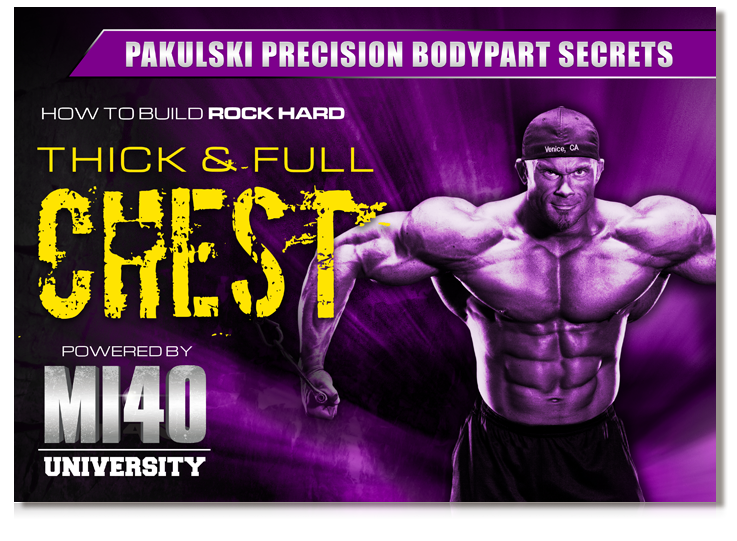
Chest training, perhaps more so than other body parts, requires an understanding of the fundamentals and elemental basics concerning movement patterns, anatomy, optimal range of motion, and intention.
Moreover, there is a great deal of misinformation littering the internet and training facilities alike.
The purpose of this section is not to give an absolute in terms of chest training and hypertrophy, but rather a guide to fundamentals that will allow you to make informed decisions regarding how to structure your future training protocols and how execute the movements included in them.
Anatomy
Pectoralis Major
The primary muscle group targeted for building a massive chest is the Pectoralis Major.
This presents the bulk of the muscle tissue and attaches from your sternum, the medial third of your clavicle and the cartilage of your ribs, to the humerus at the greater tubercle.
The main function of the Pectoralis Major is horizontal adduction of the humerus (i.e; bringing your arm across the body). It also functions in internal rotation of the arm (turning the hands and arms inward).
There are additional functions found in the ability to flex your arm in the sagittal plane, which is executed by the upper fibers.
Muscle fibers, though varying by individual, are clustered within a relatively small percent range which remains consistent throughout the population.
The Pectoralis Major is typically made up of 57%-68% fast-twitch muscle fibers (Type IIA and Type IIB). This information allows us to make informed decisions regarding the loads to apply during training.
Type II fibers are more adaptive to relatively high loads, with somewhat high to moderate rest periods between load experiences, thus, tone could argue that the bulk of your chest workout should be structured to include this loading framework (note, this doesn’t mean this should always be the case, the training affect you’re chasing at a given time may supersede this).
Movement Control
Never underestimate the importance of control with exercise execution.
Somewhat slow movements are an absolute must in order to apply the desired intentions and stimulation to a particular area, all the while reducing the possibility of injury (at least when learning a new movement pattern).
Slow tempo and lighter resistance should be implemented from the beginning to ensure movement patterns are being executed correctly. Once you have the movement nailed, you can progress to a fast concentric.
A training regimen that utilizes free weights, machines, and cables will provide the trainee with several variances in coordination and function of the muscles being worked.
Even slight changes can shift force loads to other body parts (e.g. shoulders, triceps) during compound pressing movements.
Optimal Range of Motion (ROM)
‘Perfect’ range of motion is one of the most difficult items to identify due to the changes that occur not only from every movement, but also from every individual.
In order to appropriately determine the most effective ROM, we must take into account risks and benefits associated with each movement.
The safest and most efficient way to assess your own ROM involves locating your active range of motion (AROM).
This involves using the antagonist group (thus for chest, we will utilize the muscles involved with pulling backwards) to determine how far your body will allow your muscle groups and joints to go without added resistance.
In order to determine one’s AROM for a dumbbell press, for example:
Stand still and grab two (very light) items to act as ‘dumbbells.’
Bring your arms back, making sure to keep your posture the same, much like you’re dumbbell pressing (despite being erect, not prone).
The point at which the objects in your hands stop parallel (without a shift in body position), is the point that will serve as the extreme for your ROM.
This will allow an individual to alleviate stress from the front delt, thus an increase in chest activation.
Positioning of the Shoulders
Shoulder position is perhaps the number one deterrent from chest activation, if incorrect positioning is selected.
Not only does this limit hypertrophy of the chest, but it also will inevitably increase the risk for shoulder injury.
The direction of the fibers of the pecs allow for optimal stimulation and safety at 90% adduction of the shoulders (in the transverse plane).
Scapula manipulation is extremely important to ensure optimal positioning.
Some trainees (at an advanced level) are able to control this scapula movement during the process of a given exercise.
The scapula, which moves naturally through protraction and retraction, can be controlled through proper intention and focus.
A common practice (which works great for those athletes who have deficiencies in rib-cage depth) is to completely retract the scapula during any chest movement.
This is a common trait that many powerlifters exhibit and can drastically change the angle of humerus movement.
A final point to consider is internal rotation.
When pressing, internal rotation of the glenohumeral joint is unavoidable.
When using dumbbells or utilizing flye motions, one will have the option to rotate out at the glenohumeral joint.
Staying in constant internal rotation places a large degree of stress and emphasis on the upper chest.
Proper Breathing
Often times, we are able to pinpoint improper chest mechanics to be a manifestation of an incorrect breathing technique.
It’s important to be mindful of rib-cage positioning during pec training.
Excessive exhaling during the concentric (positive, or ‘push’) of the movement will decrease the rib-cage, thus drastically altering the angle of the pecs.
Although exhalation is ideal during the concentric portion of an exercise, shallow breaths are a vital weapon for those looking to maximize hypertrophy in the chest.
Furthermore, keeping one’s rib-cage full will ensure that limited emphasis is being placed on the anterior heads of the deltoids.
Inner and Outer Pec Specificity
The contraction of the Pectoralis Major through resistance training has no effect on targeting a specific ‘area’ of the muscle.
It’s often preached that particular exercises are used to target different sections of the pecs (e.g. inner and outer pecs) due to the level of contraction.
It’s common to ‘feel’ the inner pecs being worked more thoroughly during a tighter contraction, despite there being no way to place more emphasis on that particular region.
This ‘feel’ is exacerbated by some equipment (most notably flye / pec dec machines) which place more resistance at the concentric extreme of the movement.
Incline and Decline Movements
Despite being unable to target particular lateral regions of the pecs, as described above, there is a great deal of importance that needs to be stressed concerning changing the stress load as it pertains to the shoulder joint.
We do so habitually, switching from flat to incline/ decline movements during the course of our training.
Selection of Exercises
Assessing the information so far, we are able to utilize it to create a program / training schedule that will be very efficient at setting us up for hypertrophy gains.
Furthermore, it is imperative to be aware of a movement’s resistance profile, which is basically where (in the course of the movement) the resistance is at its highest / lowest.
Although it is important to consider range of motion during all exercises, chest training in particular stresses different levels of resistance throughout different parts of the movement.
It is ideal, then, to stay within the parameters of maximum resistance for each movement when training.
A primary example would be to analyze two different flye movements – dumbbell flyes (which have zero resistance when the dumbbell is above the shoulder at the shortened end, and great resistance at the fully lengthened end of the movement) versus cable flyes (which present the opposite resistance profile).
Ideally, variation in movements that have differing profiles will constitute one’s chest workout.
In order to properly perform movements involving chest stimulation, one must fully understand the resistance profile of each to ensure optimal results.
Below are a list of common exercises that are NOT optimal for pec involvement (not to say they should never be used though) as well as alternatives for each:
Chest Dips
Dips are comparable to an extreme decline press, as the arms are in the sagittal plane and thus, the fibers of the pecs are not in a position to receive massive stimulation.
Passing beyond the active range of motion (which is extremely common) will place undue stress on the shoulders.
Instead of attempting to manipulate this movement to be more effective, it is often recommended to try a different exercise, most notably Decline Cable Presses.
To do so, use a decline bench (20-45 degrees) and place it in a narrow cable tower.
The cables should be approximately 30-45 degrees of abduction at the shoulders.
This movement drastically decreases GH joint stress and has far greater emphasis on the pec when compared to dips.
Cable Crossovers (as typically seen performed!)
Cable crossovers can present movement deficiencies due to a lack of stabilization in the trunk and/or hips.
Any such instability detracts from target specificity.
Other mistakes include standing too far in front of the cables, protracting the shoulders far too early, and not keeping the cables in line with the arms.
A movement alternative from typical execution is to place the cables slightly below the shoulders.
Performing a flye movement, the hands should be slightly below parallel to the ground to start, and during peak contraction, should be slightly above shoulder level.
This also calls for trunk stabilization though, and one should make a conscious effort to improve strength in that area if it is a weakness.
Dumbbell Flyes
As a general statement, most free weight exercises for chest present similar resistance profiles.
As aforementioned, dumbbell flyes present resistance profiles that are non-existent at the top of the movement.
Proper execution in order to stimulate the pecs at the weakest point can increase injury risk and moreover become repetitive concerning resistance profiles, if your chest training is composed of entirely free weight movements.
A great alternative would be a seated flye machine which adds resistance at the top (fully shortened) end of the movement.
To End
There are a myriad of other common mistakes that are observable in nearly every gym, including combinations of all of the mentioned mistakes, as well as moving too fast during the movement, showing a lack of tempo / control, flexing the cervical spine by lifting your head off of the bench, etc.
Creating an optimal chest routine requires a careful analysis of the fundamentals presented above.
Be careful to not fall into the hype of ‘revolutionary’ techniques, as the fundamentals will invariably remain the same.
-
Schedule
-
Sample
Please enter your name & email address below and we'll send you a sample workout from the program right away.
|
Whether your goal is to overcome genetically weak arms, or if the aim of the game is to be the FREAK in the room with the SICKEST GUNS, Ben’s got you covered! These workouts are among THE most INTELLIGENT ever created for arm development and contain some of the most effective exercise intensifiers ON THE PLANET! BOOM, it’s GROW TIME!
Program Duration:
42 Days
-
About
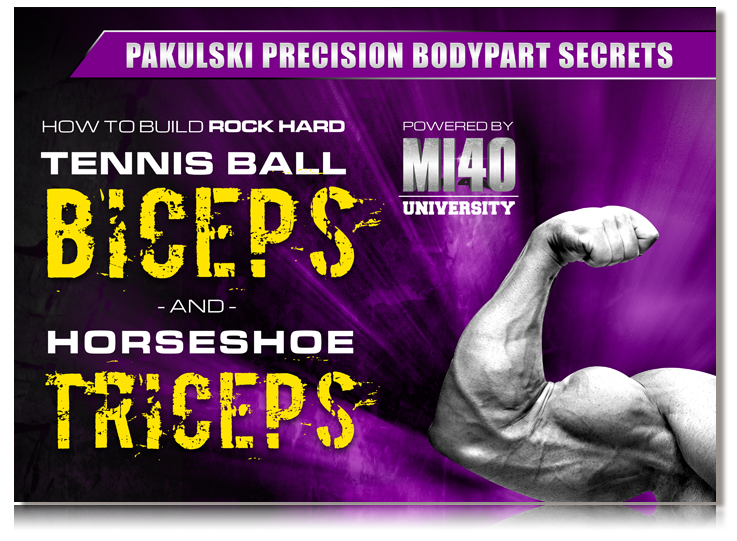
Perhaps the most universal of all physique goals includes a burning desire to get bigger arms. After all, nothing screams masculinity (or in some cases, powerful femininity, ladies ;)) louder than a pair of shredded, veiny, and bulging arms.
As with anything worth having, BIG arms require persistence and a methodological approach.
Luckily, I have great news for you.
You know all those marketable advertisements for the ‘secrets’ of bigger arms? Forget ‘em!
There are few secrets when it comes to anything in physique enhancement, especially not when it comes to blasting arms.
We’ve eliminated most of the ‘secrets’ only to leave behind the sweet ol’ principles we like to call the fundamentals.
That’s right; we’re going back to basics, boys and girls (though I’ve still got some surprise techniques, that actually work(!), incorporated into the program).
First and foremost, let’s consider when to train arms.
Do we split them up? Devote a day to both triceps and biceps together? If not, which body part(s) are ideal to pair them with?
The answers largely depend on your training regimen.
Keep in mind that volume can be increased as can frequency when devoting a separate day to arms.
From a nutritional and hormonal standpoint, however, an argument can be made for pairing biceps and triceps with their functional protagonists (e.g. biceps with back).
As a general rule, don’t be afraid to experiment and see which works best for you.
�
A second point to remember is the importance of form, as well as ‘intention’ (sound familiar? If not, check out MI40-Foundation stat!).
Exercise variations are only applicable if proper biomechanics are applied. In simple terms: if you’re not using proper form, you’re wasting your time!
Variance between dumbbells, cables, and barbells is essentially irrelevant unless every rep is performed the same, and each of the movement patterns particular to that exercise are followed.
Always remember: changes in movements DO NOT affect the shape of a muscle. You can do concentration curls until you are blue in the face; it won’t change the attachments or shape of your bicep.
Lastly, it’s imperative that we consider which of the countless exercises we will perform with an intelligent approach.
This step is a bit more complex and requires consideration of joint positions, resistance profiles, load, motor skill (from beginner to advanced training), speed of execution, and the individual’s goal (strength / size / power / endurance).
It’s impossible to create exercises (triceps for example) that work the body part through the entire range of motion. A fully lengthened tricep involves shoulder and elbow flexion with the arm over the head. A fully contracted tricep though, involves an extended shoulder with the hand behind the body.
It’s important to create a program that will incorporate all ranges of motion for your arms without repeating exercises that focus on the same area of the range of motion.
The split, exercise choice and range of motion they specifically target, as well as training volume are all hugely important considerations.
To help get you on the path to SICK sleeve-ripping arms, I’ve done all the heavy lifting for you (so to speak) when piecing this program together.
The rest is up up to you…
Keep your form in check and put in the work, homie!
In 6 weeks time, I’m confident you will have added a least a couple inches to those twigs you call arms 😉
Get your balls out of your purse and let’s do this!
Ben
-
Schedule
-
Sample
Please enter your name & email address below and we'll send you a sample workout from the program right away.
|
Want to join Ben on a personal 12 week transformation project to get ripped-up and photo-shoot ready? 6 weeks of video logs from Ben accompany this portion of the program - so you can follow along and gain insight into his unique mindset and approach. If you’re looking to lean down to carve out that hard-earned muscle and chisel away at that midsection, Project SHREDDED A.F has landed! We begin with weeks 1 - 6...
Program Duration:
42 Days
-
About
-
Schedule
-
Sample
Please enter your name & email address below and we'll send you a sample workout from the program right away.
|
Ready to step things up and bring it home strong? Weeks 7 - 12 of Ben’s Project SHREDDED A.F transformation project are here... and so is a butt-kicking! Time to be RELENTLESS in your pursuit of physique transformation success. Leave nothing on the table as you close in on the end result. Every rep counts, so put in the work now to reap the rewards in 6 weeks time!
Program Duration:
42 Days
-
About

The logic will be added here when ready. In the meantime, this workout is available for selection.
-
Schedule
-
Sample
Please enter your name & email address below and we'll send you a sample workout from the program right away.
|
Are you ready to get strong? REALLY STRONG? To move serious poundage, stability is key. CPS combines high volume, low frequency, and strategic exercises using heavy loads so you can build a rock-solid foundation & generate peak power! Significant strength increases will follow. CPS is your blueprint to becoming the immovable object... AND the unstoppable force!
Program Duration:
42 Days
-
About

Core | Power | Strength is a higher volume lower frequency workout plan with only 4 sessions per week.
The training sessions are long, but the lower frequency allows for recovery.
The Goals of CPS is to get you STRONG, really strong!
And stable.
We will maintain focus on a core group of exercises done often to master their execution – oftentimes these will be exercises that challenge your core / stability.
Focus on keeping the loads as heavy as possible.
Do NOT cheat!
When an exercise is hard, stay there – don’t be quick to give up on the rep!
Spending time where you are weak is the fastest path to increased strength.
Pay extra close attention to the prescribed sets outlining when you should hit failure during this program…
…do NOT deviate from those instructions!
Alright, enough chit-chat…
Get after it boys & girls!!
Ben
-
Schedule
-
Sample
Please enter your name & email address below and we'll send you a sample workout from the program right away.
|
An advanced next-level low frequency / high volume program for those who’ve mastered the skill of exercise & are aiming to take their results to the next level. Maintaining intensity through long workouts & feeling the effects of a taxed CNS will be the norm over 6 challenging weeks. If you’re armed & ready to step up your strength & size game, it’s time to pull the trigger with PowerBuild!
Program Duration:
42 Days
-
About

This is an advanced level program.
High volume / long workouts, low frequency.
This is for someone who has a mastery of the skill of exercise who now needs to maximize stability while continuing to add maximum muscle.
We will be training 4 days a week, plus one additional active recovery day each week.
The goal is to get better and better at putting work and effort into a smaller number of sets and workouts.
When you have fewer workouts, create a sense of urgency because you don’t get to do it again for 6 days!
These works can get very long, particularly if you don’t watch the rest periods.
The first two workouts of the week will be focused on maximizing strength and stability.
The second half of the week will be focused on hypertrophy
How to get everything out of this program:
STABILITY governs contraction.
Stability is demonstrated by showing complete control. 100% ownership over every millimetre.
Our goal during this phase is to get STRONG.
This happens when you challenge muscles and show control.
Do not rush reps.
Pay attention to what moves when you’re training. If it moves it’s either helping or making it easier.
Workout Notes:
ALWAYS NOTICE AND FOLLOW TEMPOS. THEY MATTER.
If execution specifics aren’t stated, choose whichever you prefer (e.g; quads vs. glue dominant).
Activations: Hold isometric for increased contractile ability every rep. Stop before it fatigues.
DAY 3 EACH WEEK IS AN ACTIVE RECOVERY DAY:
ADD IN 20 MINS OF HIIT, 20 MINS WALKING OUTSIDE, YOGA, ABS, 10 MINUTES OF POSING / CONTRACTING AND 10 MINS BREATHING.
Recovery and Nutrition:
This phase is taxing to the Nervous system and requires additional focus on the recovery aminos.
Here is a simple protocol to follow for pre/intra/post workout supplementation to optimize performance and recovery:
Pre Workout
- 600mg alpha GPC
- 3g Lions Mane
- 1g tyrosine
- 15g MCT oil or powder.
- Methylated B vitamin complex
Intra Workout
- 5g BCAA
- 10g EAA
- 10g Glutamine
- 5g creatine
- 2L water
- Non bicarbonate electrolytes
PWO Shake
- 20g EAA +5g BCAA
- 2 scoops chocolate greens
- 5g creatine
- 10g glutamine
- 5g glycine
- 3g taurine
- 1g magnesium
- Non bicarbonate electrolytes
- Methylated B vitamins
_____
This program will challenge you…
Get focussed. Get after it!
Ben
-
Schedule
-
Sample
Please enter your name & email address below and we'll send you a sample workout from the program right away.
|
Have you mastered your execution? Are you looking for additional upper-body focus & / or do you already have an exceptional ability to contract your legs? If the answer to both of these questions is yes, let’s drive some impressive upper-body growth over the next 6 weeks with HFU | LFL!
Program Duration:
42 Days
-
About

This is an advanced program for people who want more upper body emphasis and/or already have a great ability to contract their legs (AKA me).
For this to be successful, it’s ABSOLUTELY IMPERATIVE to have mastered your form!
I recommend you to complete Hypertrophy Execution Mastery BEFORE running this program.
If your execution isn’t mastered when performing high volume, you will end up causing injuries faster than ever.
SO pay attention.
Poor execution will also result in poor movements being locked deeper into the brain and nervous system.
If you’re not perfect yet, slow down, and make sure you are.
If you’re not ready for this phase, don’t do it.
Redo the primer phase at the very least – ideally though HEM Modules 1-5.
How to get everything out of this phase:
Remember… STABILITY governs contraction.
Stability is demonstrated by showing complete control.
100% ownership over every millimetre.
Do not rush reps.
Pay attention to what moves when you’re training.
If it moves, it’s either helping, or it’s making it easier (not what we want).
Workout Notes:
On Active Recovery Days: Add in 20 mins of HIIT, 20 mins walking outside, yoga, abs, 10 minutes of posing, and 10 minutes of deep breathing.
Okay… enough chit chat!
Get set…
Go!
Ben
-
Schedule
-
Sample
Please enter your name & email address below and we'll send you a sample workout from the program right away.
|
This high frequency arms & delts program is designed around increasing volume & frequency in opposing waves. Either volume or frequency will increase each week to ensure consistent progression. If you’re ready to add some significant inches to your arms & delts, you’re ready for this program!
Program Duration:
42 Days
-
About

The Arm and Delt Specialization program is designed around increasing volume and frequency in opposing waves.
In weeks 2, 4, and 6 the number of sets per body part in a given week increases.
In weeks 3 and 5, the weekly volume scales back slightly to accommodate for recovery as training frequency continues to go up.
Either volume or frequency will increase every week.
The slightly lower total volume starting in week 1 is a necessary jumping off point to allow the body to begin in an optimal state to ensure weekly progression.
If your goal is to add extra growth to your arms and delts, this is the program for you.
Ben
-
Schedule
-
Sample
Please enter your name & email address below and we'll send you a sample workout from the program right away.
|
Description will be added soon — if you’d like to get started on the program right away, it’s available for download now!
Program Duration:
42 Days
-
About

The logic behind the program will be explained here soon!
If you’d like to get started on the program right away, it’s available for download now!
-
Schedule
-
Sample
Please enter your name & email address below and we'll send you a sample workout from the program right away.
|
Whether your goal is 16” of beach ready pipes, or 23” Mr. Olympia competitor guns, the principles for arm growth are exactly the same. It’s like a stepladder to the top, and where you stop is your choice. I made ALL the common mistakes in arm training, but my persistence (and stubbornness) led to me identifying the simple errors many people are making, and most importantly, how to take those mistakes and teach YOU how to add inches to your arms in half the time.
Program Duration:
30 Days
-
About
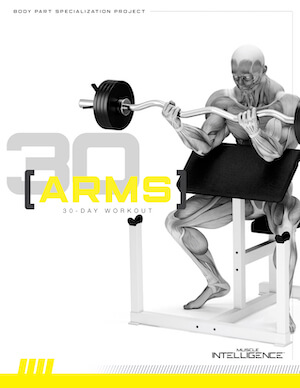
“IT’S NOT ABOUT THE CAR YOU DRIVE, IT’S THE SIZE OF THE ARM HANGING OUT OF THE WINDOW!”
This is the slogan on a street sign positioned directly outside of The Mecca of Bodybuilding, Golds Gym in Venice, California. I tend to agree.
___
A great set of pumped and rock solid guns is the first thing everyone sees, grabs and comments on. If you like the idea of commanding instant respect and admiration, building a set of sleeve stretching guns is key.
Whether your goal is 16” of beach ready pipes, or 23” Mr Olympia competitor guns, the principles are exactly the same. It’s like a stepladder to the top, and where you stop is your choice.
I made ALL the common mistakes in arm training, but my persistence (and stubbornness) led to me identifying the simple errors everyone is making, and most importantly, how to take those mistakes and teach 100,000 men and women how to add inches to their arms in half the time.
BEFORE WE BEGIN:
If you’re jumping into this program without going through the Arm training guide first, STOP now and go read the guide, watch the videos, and take one or two action points from the guide and apply them to each workout.
This program, or any program is only as good as your ability to execute it. The goal of this program is to teach you mastery of the SKILL of Arm training.
Training, is not about WHAT you do, it’s HOW you do it.
The goal of this 30 day program is to lay the foundation for lifelong growth.
This program is high frequency, so you will have plenty of repetition that is necessary to learn. Do not stray from the program. A lot of time and thought went into everything in this program.
The foundation of progress for all muscle building exists within 3 aspects that are built into this program: Mobility, Skill, Stability.
You will need all 3, and your ability to master all 3 will determine your ability to build muscle. It’s as simple as that.
This is the foundation of all growth.
No manipulation of sets and reps and volume and load will build maximum muscle without the foundation of execution mastery…
___
NOW GET TO WORK!
-
Schedule
-
Sample
Please enter your name & email address below and we'll send you a sample workout from the program right away.
|
The goal of this program is to teach you mastery of the SKILL of back / lat training. It’s not about WHAT you do, it’s HOW you do it. Unearth new growth while learning how to lay the foundation for lifelong back / lat development over the next 30 days.
Program Duration:
32 Days
-
About
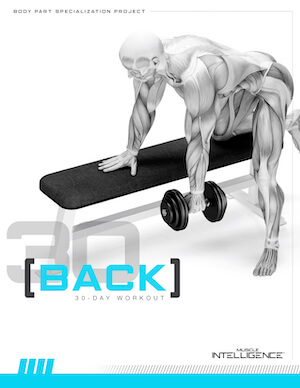
“I CRACKED THE CODE FOR BACK TRAINING.”
___
The goal of this program is to teach you mastery of the SKILL of back training.
Training, is not about WHAT you do, it’s HOW you do it.
The goal of this 30 day program is to lay the foundation for lifelong growth.
This program is high frequency, so you will have plenty of repetition that is necessary to learn. Do not stray from the program. A lot of time and thought went into everything in this program.
The foundation of progress for all muscle building exists within 3 aspects that are built into this program: Mobility, Skill, Stability. You will need all 3, and your ability to master all 3 will determine your ability to build muscle. It’s as simple as that.
This is the foundation of all growth.
No manipulation of sets and reps and volume and load will build maximum muscle without the foundation of execution mastery.
THE MISSING PIECE TO WIDE AND THICK LATS:
Hopefully by now I’ve driven home that exercise execution is the key to building muscle.
But specifically here are the about 5 things that are most important for you to focus on for building a bigger, wider, thicker back without pain or injuries:
1) You MUST have strong spinal extensors.
If your back is rounding when you’re doing back, your lats will not grow. You will compensate with poor movements and ultimately make your ability to build your back harder and harder. Start off by doing things correctly from day one. This skill is built directly into the training program.
2) You MUST have external rotation of the shoulder (turn your biceps to the ceiling).
3) You MUST be strong and stable in protraction and external rotation, and be able to maintain it while initiating with the lat (and for the majority of the rep).
4) You MUST learn to keep the tension on the lats at all points of every rep.
5) DO NOT retract the scapula.
I repeat… DO NOT retract the scapula if your goal is lat training.
In fact, often times the cue that helps most is protracting the scapula and emphasizing that in the beginning
of the range.
___
FOCUS, AND LET’S BUILD BIG LATS!
-
Schedule
-
Sample
Please enter your name & email address below and we'll send you a sample workout from the program right away.
|
Ever wonder why two people can do a bench press and one will get huge pecs, while the other only gets sore shoulders? Genetics? Of course... but not necessarily for the reasons you may think. If you want a chiseled chest and boulder shoulders, learn to do things right, starting today.
Program Duration:
30 Days
-
About
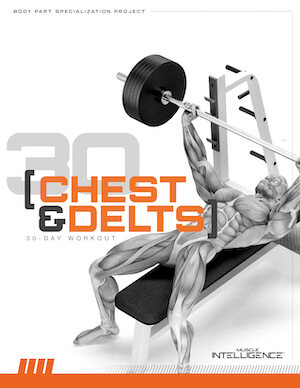
“YOUR GOAL IS TO BUILD A BIGGER CHEST AND DELTS? – CONSIDER IT DONE!”
___
THE KEYS TO BIG PECS:
Ever wonder why two people can do a bench press and one will get huge pecs, while the other only gets sore shoulders?
IS IT THEIR “GENETICS”?
Of course it is. But when it comes to building muscle, genetics doesn’t mean what most people think it does…
It’s not about one person being able to build muscle and the other not being able.
I believe if you can build one muscle, you can build them all. You just haven’t learned how to put tension through that muscle yet.
Genetics, with respect to muscle building seems to be most impacted by someones proportions, their ability to execute a skill and therefore… their ability to place tension directly into a single muscle.
So, that’s what we focus on. Teaching you how to set up an exercise for YOUR body to direct maximum tension through a muscle.
Not simply mindlessly lifting weight. Teaching you the keys to maximizing tension, and avoid the common mistakes that rob you of all the progress.
BIGGEST MISTAKES IN CHEST TRAINING:
During the program, we’ll get into plenty more of these, but here are 5 to get started:
- Thinking that flat bench is for lower pec, and incline is for upper (HINT: it’s not for 90% of people).
- Not giving setup and stability more attention.
- Not keeping the shoulders retracted at the beginning of the movement.
- Not lining up the pec fibres you’re looking to train with
the angle of the resistance (Set up).
- Not training the fully shortened position.
5 KEYS TO STRONG AND ROUND DELTS:
- Stability at the trunk and scapula will ensure maximum tension in the right place.
- Sit tall, stand proud.
- Once you’ve picked your setup position, lock it in place.
- Learn to see the direction that the resistance is being applied (ex. dumbbell = down), and what muscle is best positioned to resist that.
- Determine AROM (active range of motion). Internal and external rotation of the shoulder joint. (*no scapula movement), and downward/upward rotation of the scapula.
___
POWERFUL PECS & ROUND-CUT DELTS AWAIT!
-
Schedule
-
Sample
Please enter your name & email address below and we'll send you a sample workout from the program right away.
|
Top athletes, bodybuilders, and figure athletes come to me to accelerate their backside and learn how to optimize training for their body’s.
Here’s the great thing, it’s always the same small number of things that everyone does wrong, that when identified, addressed and corrected with strict adherence to the plan, make a massive difference in way less time than most people believe is possible. Discover what you need to know to develop powerful glutes and hamstrings over the next 4 weeks with this precision primer.
Program Duration:
28 Days
-
About

“BUILDING GREAT HAMSTRINGS AND GLUTES, IS SOMETHING I’VE BECOME KNOWN FOR AROUND THE WORLD.”
___
Top athletes, bodybuilders, and figure athletes come to me to accelerate their backside, and learn how to optimize training for their bodies.
Here’s the great thing, it’s always the same small number of things that everyone does wrong, that when identified, addressed and corrected with strict adherence to the plan, make a massive difference in way less time than most people believe is possible.
Much like all other body parts, hamstrings and glutes are dependent on precision execution to direct maximum tension into the muscle while minimizing the contribution of other surrounding muscles.
If you take the time to learn how to do the small number of exercises in this program, first do them near perfectly, then learn to work hard, muscle growth is not a matter of “if”, but instead simply a matter of when.
HERE’S THE CATCH:
The best program in the world is only as good as your ability to execute it.
Execute with strict adherence to mastering the form, increasing the ability to stabilize so you can scale the load without losing the positioning, then once you’ve locked all that in stone, putting in effort far beyond what you ever thought was possible.
THIS IS IMPORTANT:
You’ve probably NEVER worked hard in your life.
Why?
Because gritting your teeth and mindlessly slinging weights is not muscularly hard. It might be neurologically taxing (taxing to the nervous system, so you feel “exhausted”) but it’s not a direct and concentrated stimulus to the muscle.
To truly work hard at challenging the muscle, you must first create the correct starting position and maintain
it as you increase the load and work. When you finally “get it”, your muscles grow but you don’t feel as tired, fatigued and beat up after workouts.
It’s a beautiful thing that allows you to train more often, grow faster, and massively decrease (likely completely eliminate chance of injury).
When learning the things to focus on, high frequency is a big part of the process. The total amount of work in each workout might feel low, but thats the point.
We don’t want overall fatigue.
We need perfect practice, and that requires you to feel like you’re never digging a huge hole with your energy. You’re going to do the same exercises a lot, smile, say thank you, and become the master of these exercises over the next 30 days. Aim to get better and better at every single rep. NEVER to simply complete reps and sets.
___
IT’S FINALLY TIME TO WORK HARD!
-
Schedule
-
Sample
Please enter your name & email address below and we'll send you a sample workout from the program right away.
|
“Hey Ben, how do I build big quads?”
– I get this question multiple times a day. This intensive primer program will teach you all you need to know to lay the groundwork for quad-building success. 5 weeks to tree-trunk legs. Get after it!
Program Duration:
35 Days
-
About
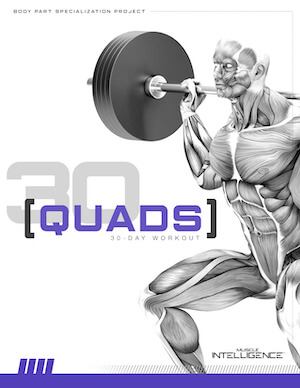
“HEY BEN, HOW DO I BUILD BIG QUADS?”
– I get this question multiple times a day…
___
HERE’S WHAT TO DO:
Before we begin, it’s vital to know that you don’t “need” to squat to build big legs.
What you do NEED is pelvic and spinal stability. Guess what’s great for functional pelvic and spinal stability?
You guessed it. Squats and lunges.
If you don’t have a stable pelvis, you will never build muscle to your full potential.
You’ll get hurt well before you ever have a chance.
So, are squats necessary to build great legs? Yes, but not for the reason that most people think.
Think of it this way, when I’m standing up straight, my body is most stable because of the stacking of bones.
The further I bend, i.e., deviate my center of mass into a squat, deadlift or lunge, etc., the less my body can just passively rely on bones and now has to actively use muscles to stabilize joints.
The more time you spend at these structurally unstable positions, like the bottom of a squat or lunge, the more your muscles adapt and become able to produce stability.
In stating this, your limitation to building great strong legs, is not your ability to work hard, but your ability 3 to generate stability. The body will down regulate, i.e., turn down, your ability to contract muscle if it senses instability.
When muscles decrease contraction due to instability and yet you have heavy load on your body, your body is left with no choice but to use ligaments, tendons, bones, and joints to stabilize. Bad news.
You can also see why people that avoid deeper squats for fear of knee pain are in fact contributing directly to the problem. Most knee pain comes from unstable hips and feet. Not the knee itself or the exercises you choose.
Stability does NOT come from standing on an unstable surface. That’s more of a party trick. Stability comes from challenging the body in positions of instability.
Positions of instability are the positions in any exercise that aren’t dependent on structure, such as bones or joints. This is important to know.
HERE’S HOW THIS WORKS:
The best program in the world is only as good as your ability to execute it. Focus 100% of your attention over the next 30 days on PERFECT execution, and maximizing the skill of creating stability.
I define stability as the ability to NOT move.
Your ability to build bigger legs will be a 1-1 correlation with your ability to master the skill of executing the squat and lunge with rock-like stability of the spine and pelvis.
The leg extension and hack squat are there to improve your contractile ability of the quads in isolation, squats and lunges will focus on the integration of this new contractile ability into the core movements to avoid joint imbalances and injuries.
Your frequency will be very high in this program, so volume will be very low. Do not do more. Place your attention and effort into putting more focus and effort into every single rep and set.
Aim to make every rep perfect and every inch more challenging to the muscle; never simply completing reps and sets.
___
LET’S GET TO WORK!
-
Schedule
-
Sample
Please enter your name & email address below and we'll send you a sample workout from the program right away.
|
The logic of this program is to master the big 8 training patterns. You will train each exercise within every rep range – each of the 3 systems will be taxed: metabolic, hypertrophy, neurological. The frequency of training will be higher that you’re used to for each primary muscle-group... work hard and show up excited to chase your greatness!
Program Duration:
28 Days
-
About

THE AIM OF THIS PROGRAM IS TO MASTER THE BIG 8 TRAINING PATTERNS.
___
HERE’S WHAT TO DO:
You will train each exercise within every rep range, each of the 3 systems will be taxed on a different day.
Mondays are metabolic and skill focused.
Wednesdays are hypertrophy focused, and Fridays are neurological before taking two days “off”.
You will require less carbs and higher protein on the weekends so adjust accordingly.
Yes, the frequency is higher than you’re used to.
Good, become exceptional at the basics.
Yes, it might be boring.
Good.
Learn to focus.
Being great at these is vital to long term success.
DO NOT aim to simply complete exercises and “get the workouts done”.
Show up excited to chase your greatness.
Anchor passion into every workout.
DO not be afraid of what people think.
Do not be afraid of being sore, tired, or performing poorly.
Do each rep perfectly and never let anything less enter your mind.
___
COMMIT TO 4 WEEKS OF THIS. YOU WILL GROW.
-
Schedule
-
Sample
Please enter your name & email address below and we'll send you a sample workout from the program right away.
|

